New Trip Report: Ecuador, 2021
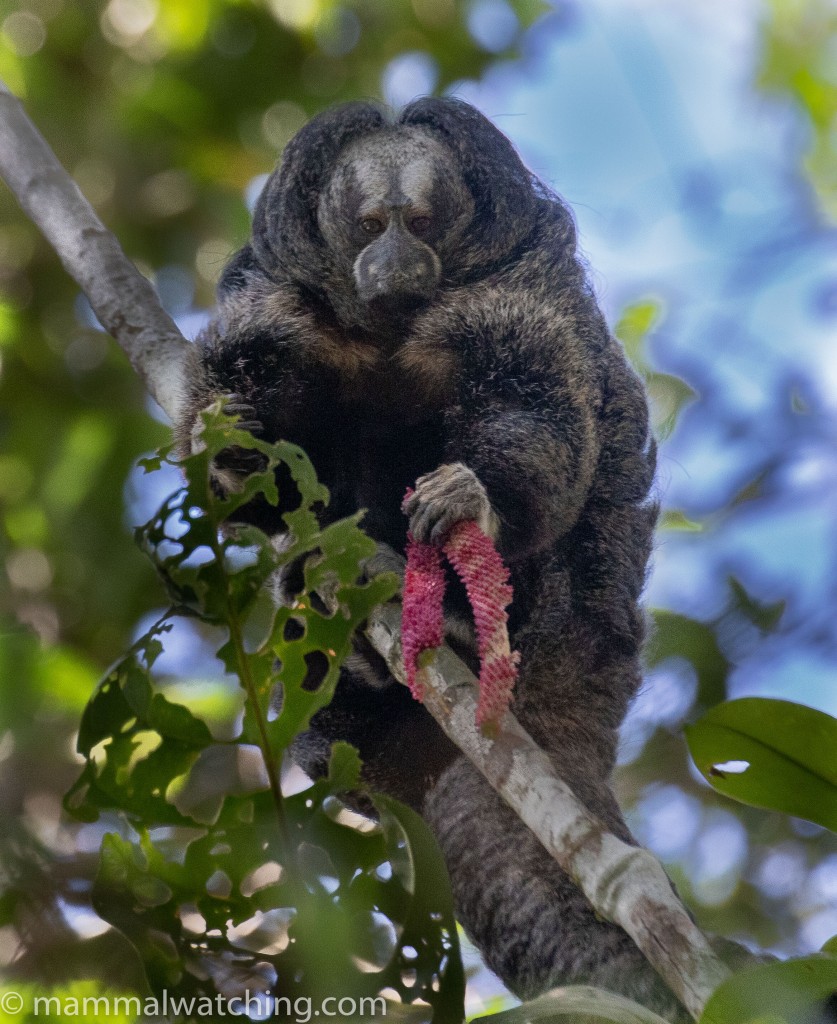
Napo Saki, Pithecia napensis, Napo Valley
In early 2021 I published a short report from Karina and Andre Giljov, who had uncovered an apparently reliable spot for Mountain Coati in Mindo. I was gripped. So were others. This was a species I had wanted to see for a while. But after seeing their pictures – of an animal they beautifully described as resembling a Wolverine/Tayra hybrid – I was looking at flights to Quito.
I should have gone straight away. Instead I decided to wait a few months and take a longer trip to combine a return to mainland Ecuador with the Galapagos. This was a terrible decision as – spoiler alert – I didn’t see a Mountain Coati.
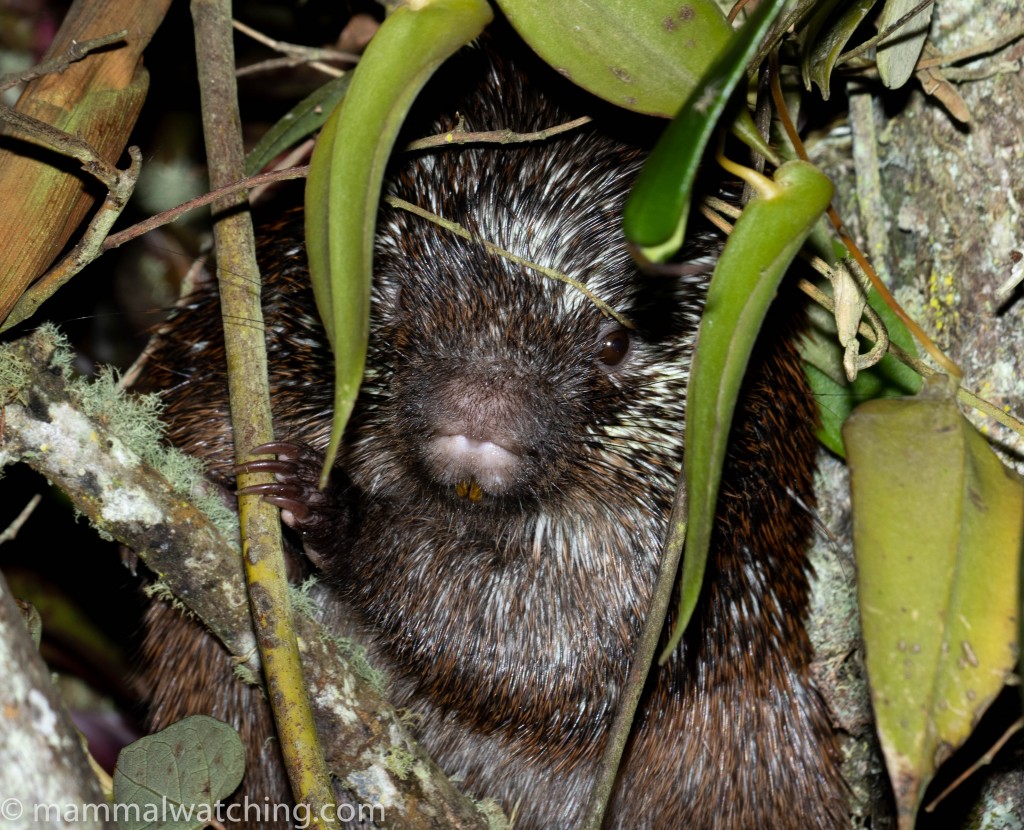
Stump-tailed Porcupine, Coendou rufescens. Papallacta
And so after a week in the Galapagos with Amber, I waved goodbye to her and said hello to Alex Meyer who was joining me for the week before he continued on to Brazil.
I was a little nervous about traveling with someone I didn’t know well, wondering how I could possible live up to Tomer Ben-Yehuda as a mammal-watching travel buddy (for details of their epic bromance see either Tomer’s or Alex’s trip reports from their 2021 trip around Uganda).
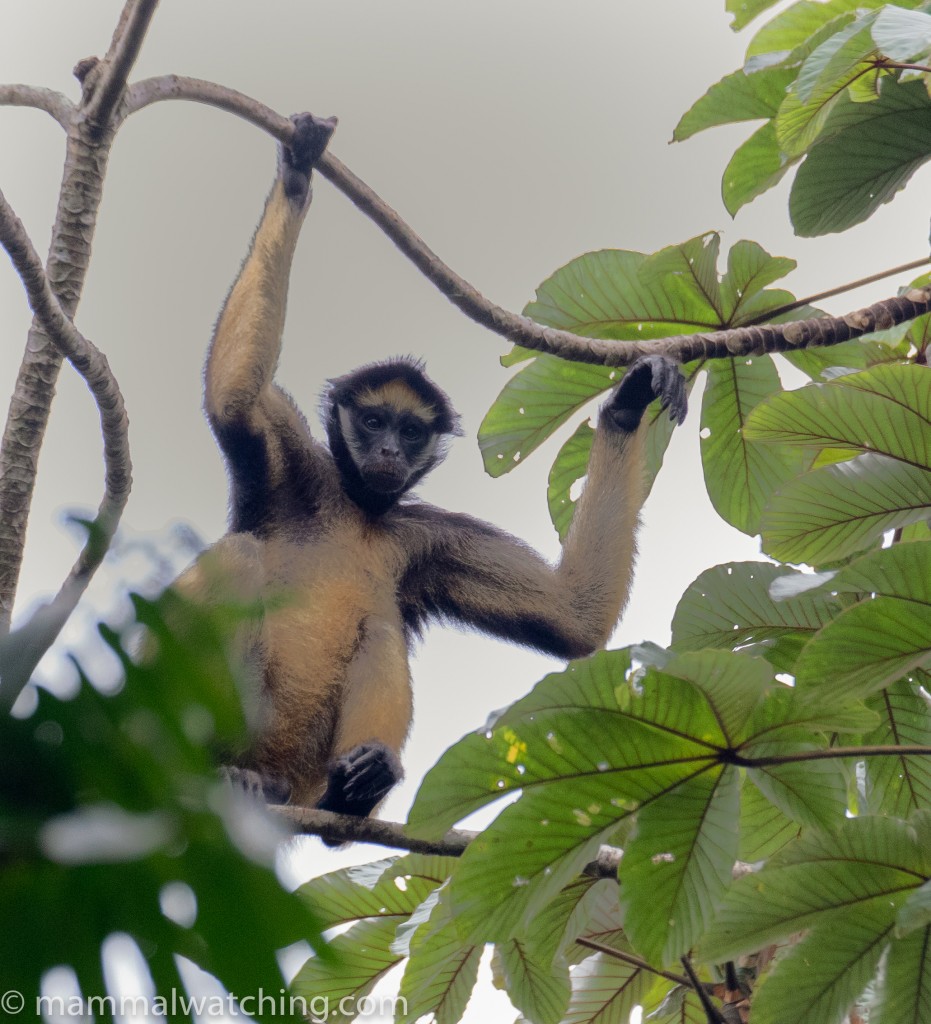
White-bellied Spider Monkey, Ateles belzebuth. Napo Valley
Itinerary
This was my third time in Ecuador and I planned the week around looking for the Mountain Coati, and a hit and run trip to several sites for particular lifers. The itinerary was partly inspired by Ian Thomson’s , John Rogers’ and Cheryl Antonucci’s recent trips.
Day 1: Rio Canande Reserve (Brown-headed Spider Monkey) stopping at Mindo en route for a Mountain Coati watch.
Day 2: Bellavista Lodge, stopping at Mindo en route for a second Mountain Coati stake out.
Day 3: Papallacta (Dusky Shrew-opossum and Stump-tailed Porcupine) stopping at Mindo en route for another Mountain Coati watch.
Day 4 & 5: San Isidro Lodge (Grey-bellied Night Monkey).
Day 6 – 8: Napo Wildlife Centre (White-bellied Spider Monkey and Napo (Monk) Saki).
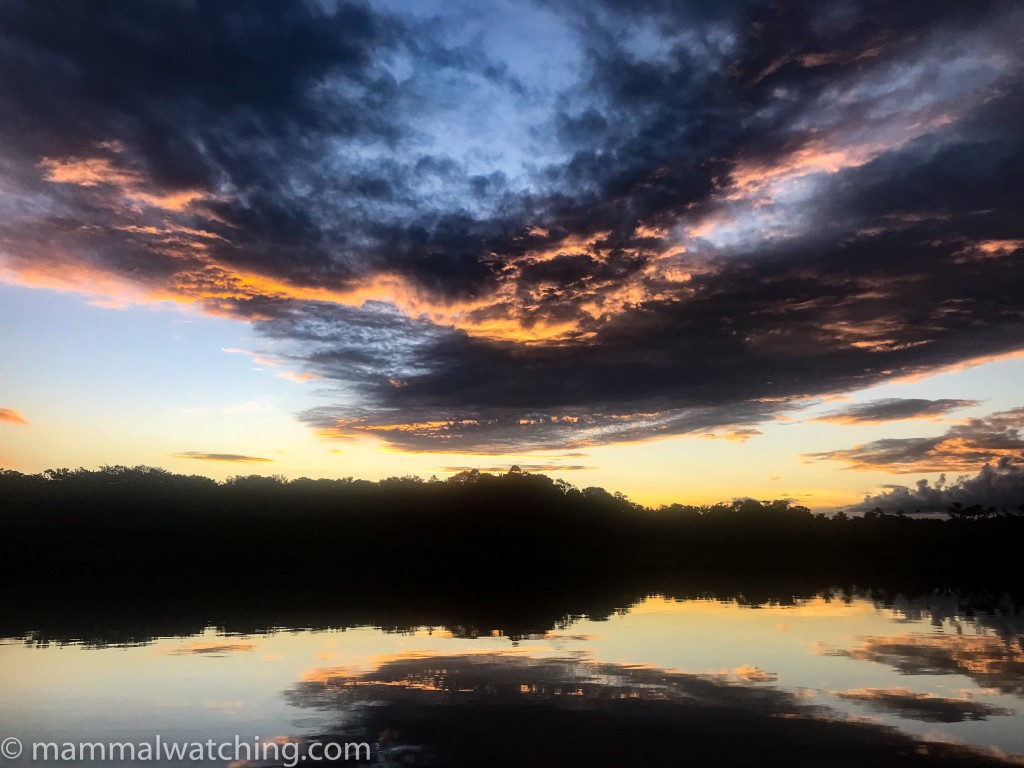
Napo Wildlife Centre
On Ian’s advice I used Jocotours to organize some of the trip. They are nature-travel specialists but more importantly, as an NGO, manage 15 reserves in Ecuador. You have to contact them to organize a stay at Canande, but I also asked them to book San Isidro and Bellavista. Adela Espinosa there is excellent, and we have an email chain of over 100 messages to prove it. She helped organize a bunch of other things for our trip that she was not actually responsible for, including talking to guides in Papallacta and responding to my many and overly-detailed questions.
Jose Gallardo – Gallardo Tours – drove us around. Jose was my driver in 2012 and he is just as good now as he was then. Maybe better: I am sure his English has improved. In fact Jose is more of a guide than a driver, he speaks good English, knows all the sites, is reliable and super hard working. Plus he was much cheaper than the other options I was quoted including just taking transfers between the different sites.
He is also a good spotter and knowledgeable about the wildlife. Even better he is genuinely interested in it too, accompanying us on excursions in Coca Cayembe for example even when he was not officially working. This meant I could feel less guilty about all the hours he was working. Very highly recommended!
San Tadeo
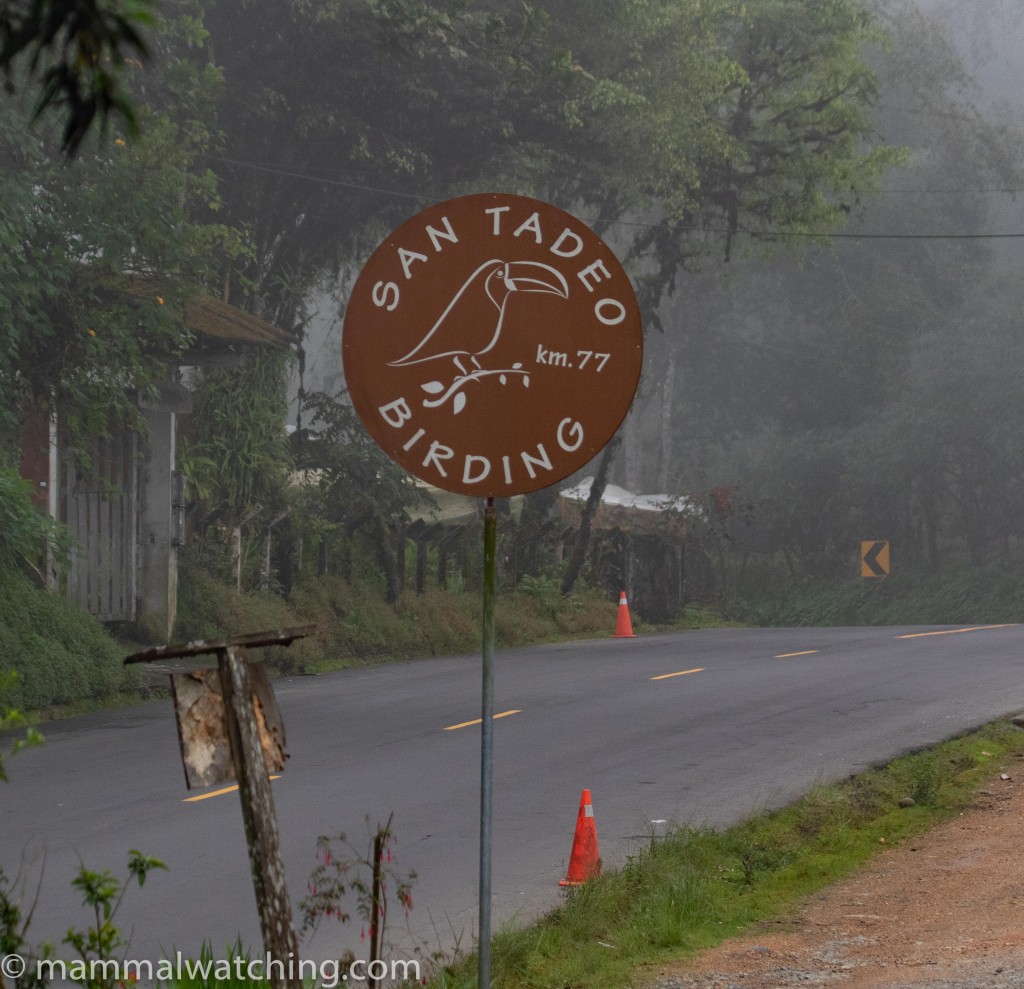
The San Tadeo birding guard is close to Mindo and less than 2 hours’ drive from Quito airport. This is the place where Andre and Karina repeatedly saw a Mountain Coati in February, and where Cheryl Antonucci saw one during an hour’s visit in April.
The “garden” is basically a small patch of sloping forest, with fruit on one level and some hummingbird feeders 20 meters lower down a trail. There is a small fee to get in and the lady who runs the place will rustle up coffee and sandwiches. I’m not quite sure whether there are any opening hours as such. It sort of opens about 6.30 a.m., or at least that is when the fruit is replenished each day. But I understood we could have arrived earlier if we wanted andI didn’t see any gate.
We visited three times over three consecutive days. From 7-10 a.m., from 2-5 p.m. and from 6.30-11.30 a.m.
A coupe of weeks before my visit Adela from Jocotours spoke to the birding garden and was told that the Mountain Coati had stopped visiting. I am not sure if that is regular seasonal behavior, or if its visiting the garden was unusual in the first place. Either way it was the worse news since discovering the Games of Thrones finale wasn’t an elaborate hoax.
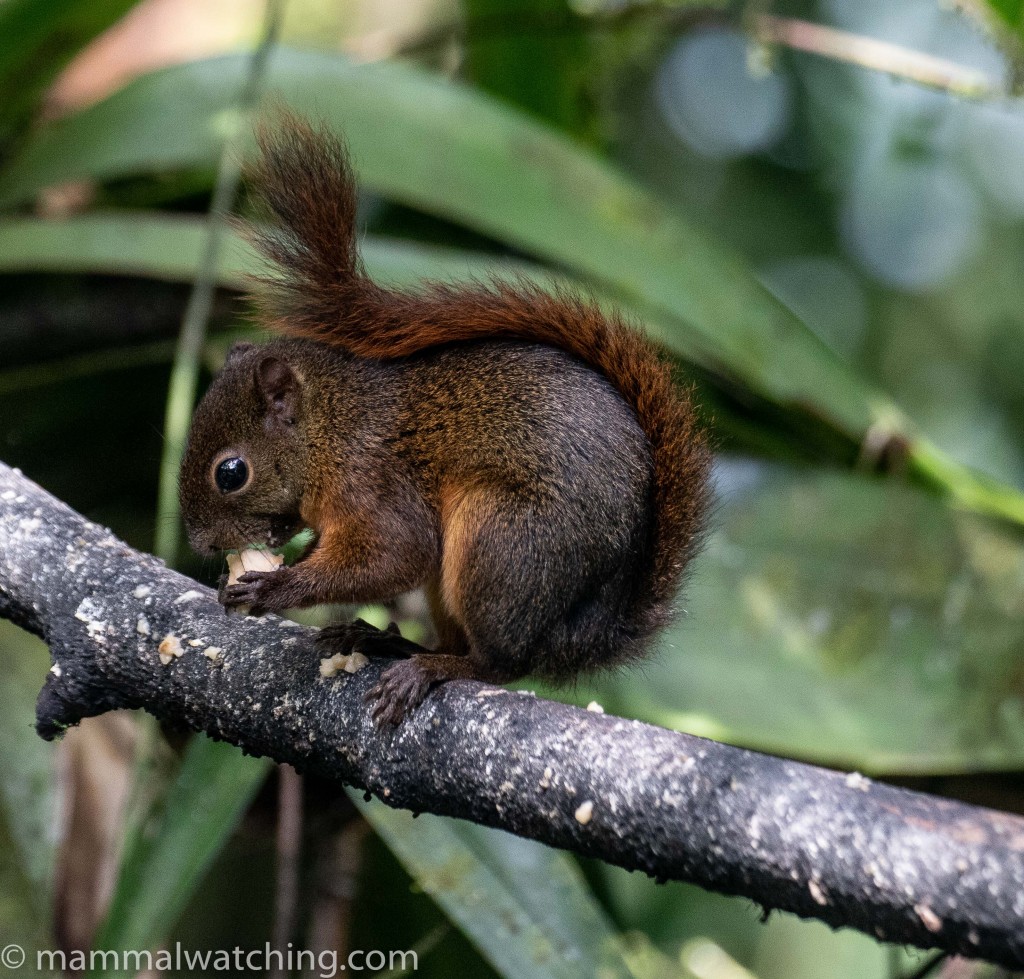
Red-tailed Squirrel, Sciurus granatensis
But I was determined to be optimistic, refusing to believe that the coati would disappear so selfishly. When we arrived the garden manager said she had seen it the day before at 9 a.m. and that it was still visiting, just not hanging around for as long as it used to. At least that is what I think she said: Jose was translating all this. She had also seen a Tayra 30 minutes before we arrived. So, optimism levels recharged, we sat and waited. And waited. And waited.
During a total of 11 hour, across three days, we didn’t see a Mountain Coati. Nor did we see a Tayra. But we did see several Red-tailed Squirrels, who were always close by, together with a couple of Central American Agoutis, though only for a few minutes during our second visit.
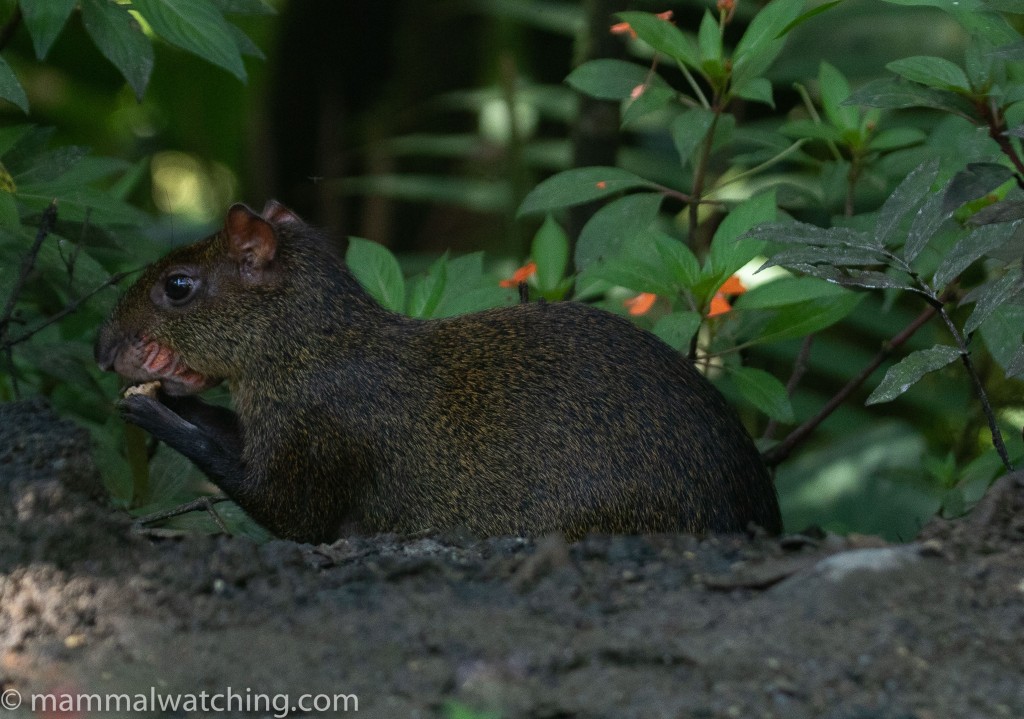
Central American Agouti, Dasyprocta punctata
Alex spotted a medium sized rodent, which I also saw through the thermal scope, but neither of us saw it well enough to hazard an ID. Maybe it was a Cotton Rat given it was active at 10 a.m. Maybe not.
We also saw a small, dark shrew on two occasions dashing across the stones in front of the feeding station. There are only four shrews in all Ecuador, and only two in this area: Cryptotis osgoodi and the very similar C. equatoris (a split from osgoodi). The gardens are at 1400 meters elevation. According to Diego Tirira’s excellent Mammals of Ecuador field guide, Osgood’s shrew is not found below 1800 meters and also seems just out of range. While the Ecuadorean Small-eared Shrew (C. equatoris) is found from 1600 meters and seems to be just in range. So we recorded it as that species though I would feel better about my lifer if I knew someone who had caught the shrews there.
Choco Lodge Canande
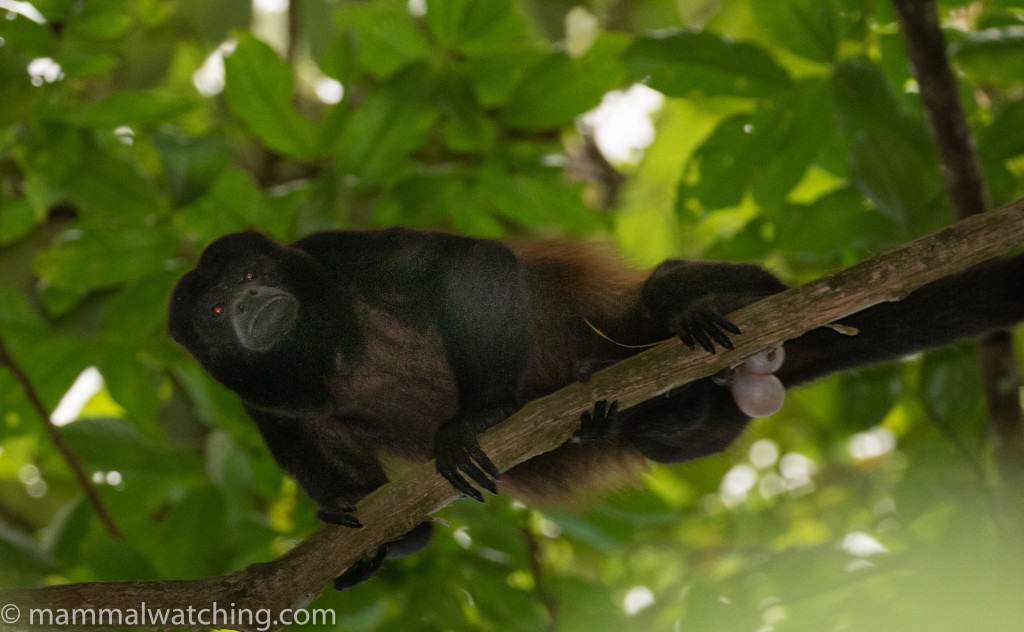
Mantled Howler Monkey, Alouatta palliataa equatorialis
It only took 3 hours or so to reach Canade from Mindo. The journey involves ferrying the car a hundred meters across a river on a barge powered only by a canoe with a small outboard. If the river is running high the barge won’t operate.
The lodge is simple but comfortable an the food was great. As Cheryl mentioned in her report the rooms are right next to the road so it is not peaceful, unless you enjoy the sound of clapped-out logging trucks chugging up the hill. But when the new rooms, further into the forest, are ready this will no longer be an issue, even if logging still is.
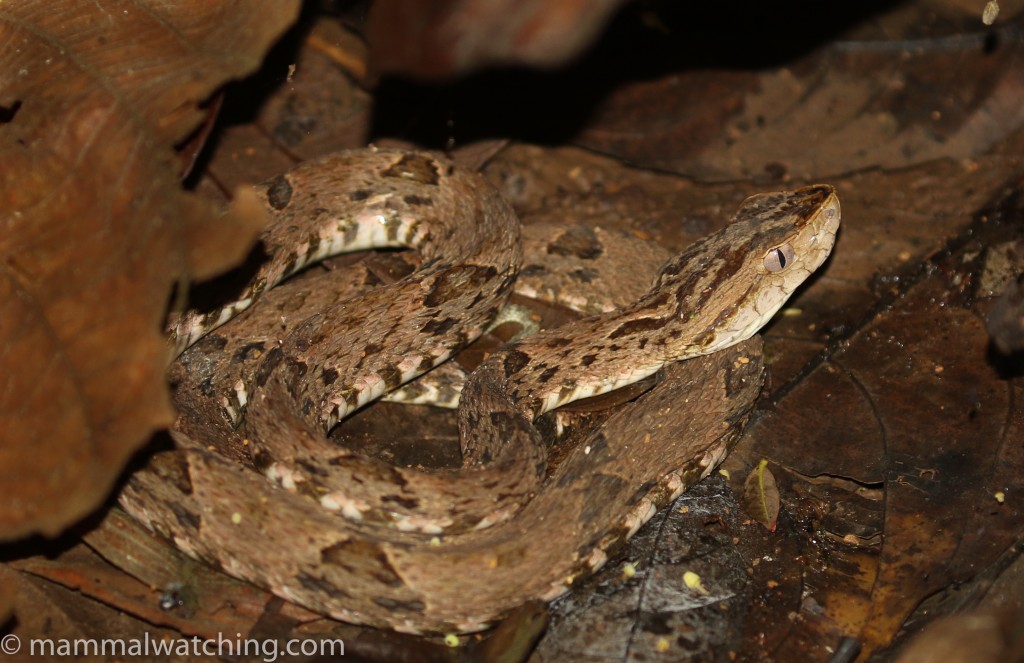
Fer de Lance
We came here to see the critically endangered Brown-headed Spider Monkeys. A species that ought to be very easy to see here according to other trips reports. I though we would find them on our first afternoon and be able to leave tearly the next morning to return to San Tadeo and a Mountain Coati watch.
But during a 2.5 hour hike in the late afternoon, in some of the worst humidity I’ve ever experienced, we heard distant spider monkeys but did not get close to seeing them. The only mammals were a few of the Ecuadorian subspecies of Mantled Howler Monkeys close to the lodge.
It started raining on dusk and kept raining all night. I didn’t go out but Alex looked around the gardens a little and saw a Nine-banded Armadillo.
We were back in the forest at 7.30 a.m the next morning and it took us 20 minutes to spot some Brown-headed Spider Monkeys, though photography in the drizzle and cloud cover was difficult.
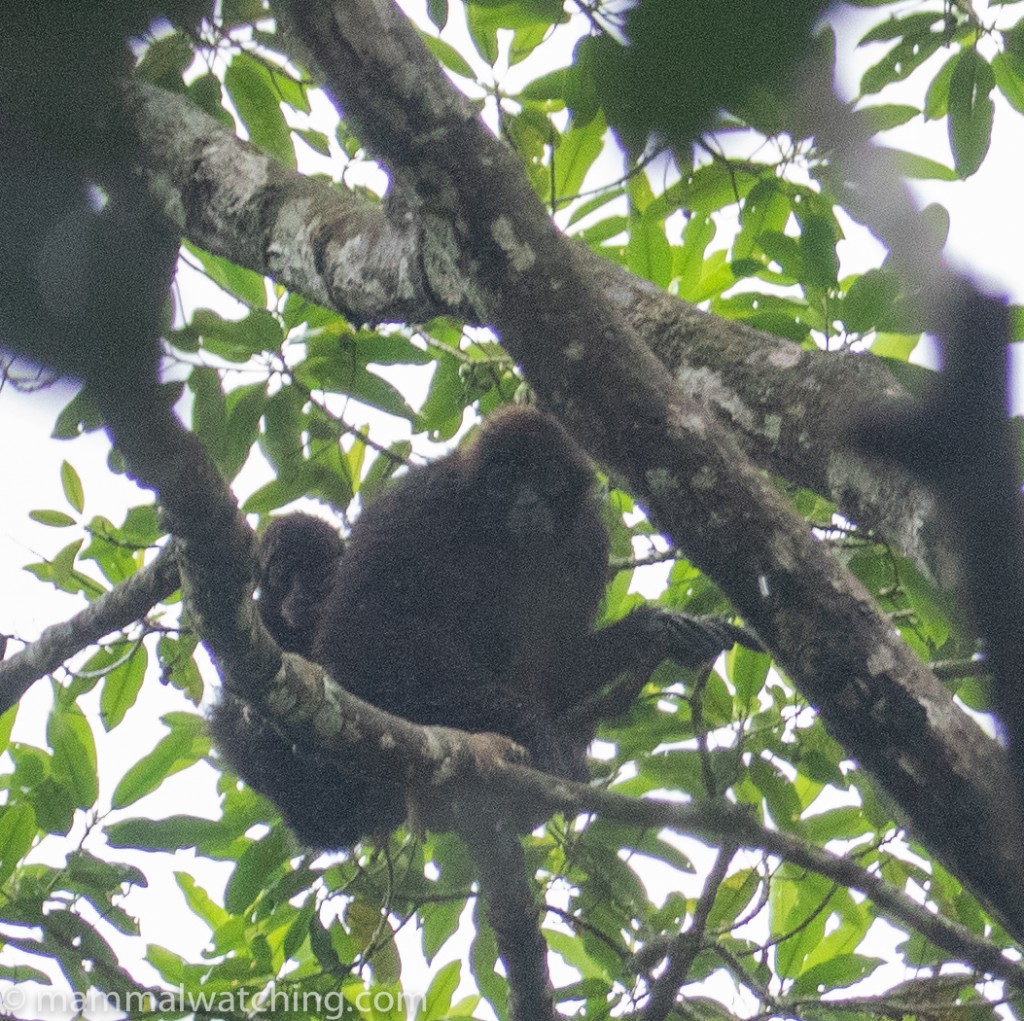
Brown-headed Spider Monkey, Ateles fusciceps
There are Colombian White-faced Capuchins here too, though they do not seem easy to find. So after seeing the spider monkeys we returned to the lodge, stopping only to watch more howler monkeys, and set off back to Mindo to dedicate more time to looking for the Mountain Coati.
Bellavista
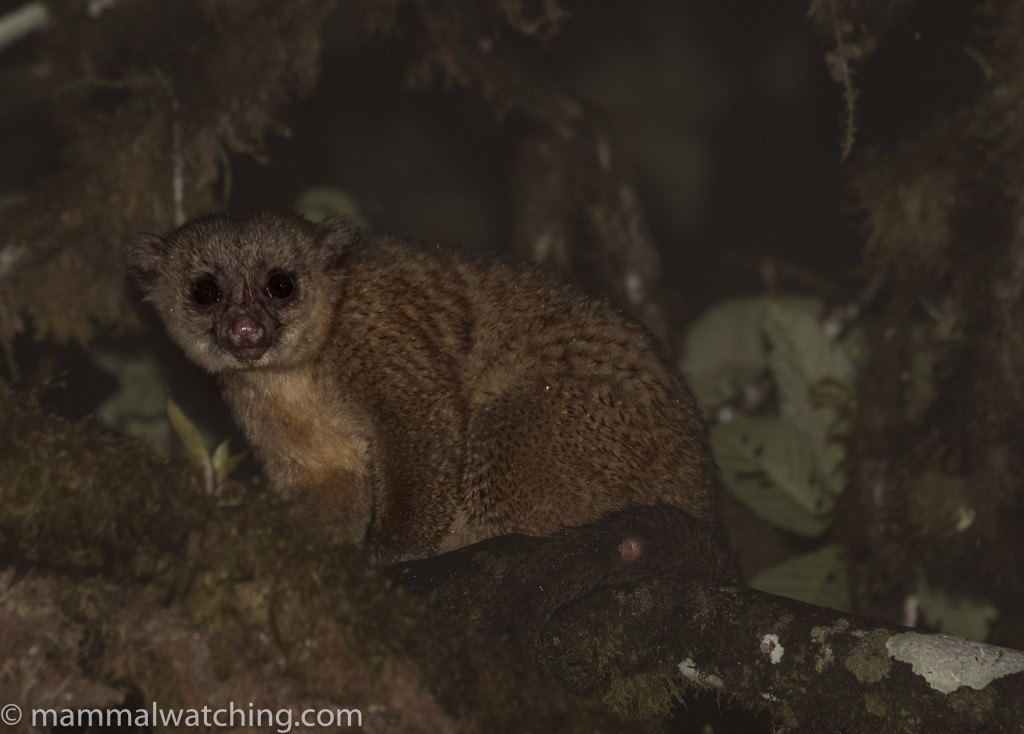
Olinguito, Bassaricyon neblina
I spent three nights in Bellavista in 2015. I like it here, returning this time primarily because it was convenient to the San Tadeo Birding Garden. We arrived at 5.30 p.m and left at 5.30 a.m so didn’t expect to see a great deal, including the cat – apparently an Oncilla – that was being seen regularly along the trails during the day.
But we did enjoy a delicious dinner, interrupted by lodge staff letting us know when an Olinguito and Andean White-eared Opossum were at the feeding station.
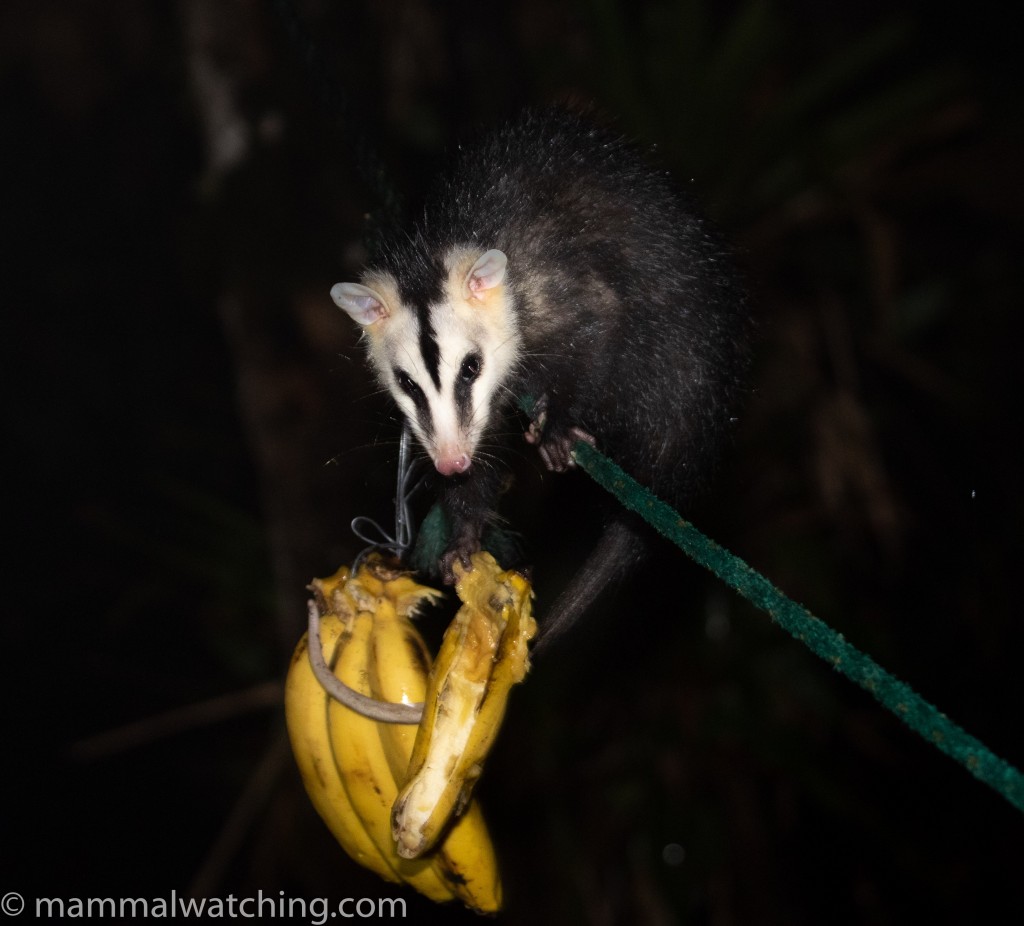
Andean White-eared Opossum, Didelphis pernigra
Back in 2015 Kinkajous were abundant but we didn’t see any. Nor did I see any of the Tube-lipped Tailless Bats (Anoura fistulata) that were all over the hummingbird feeders in 2015. Perhaps they were less active because it was drizzling.
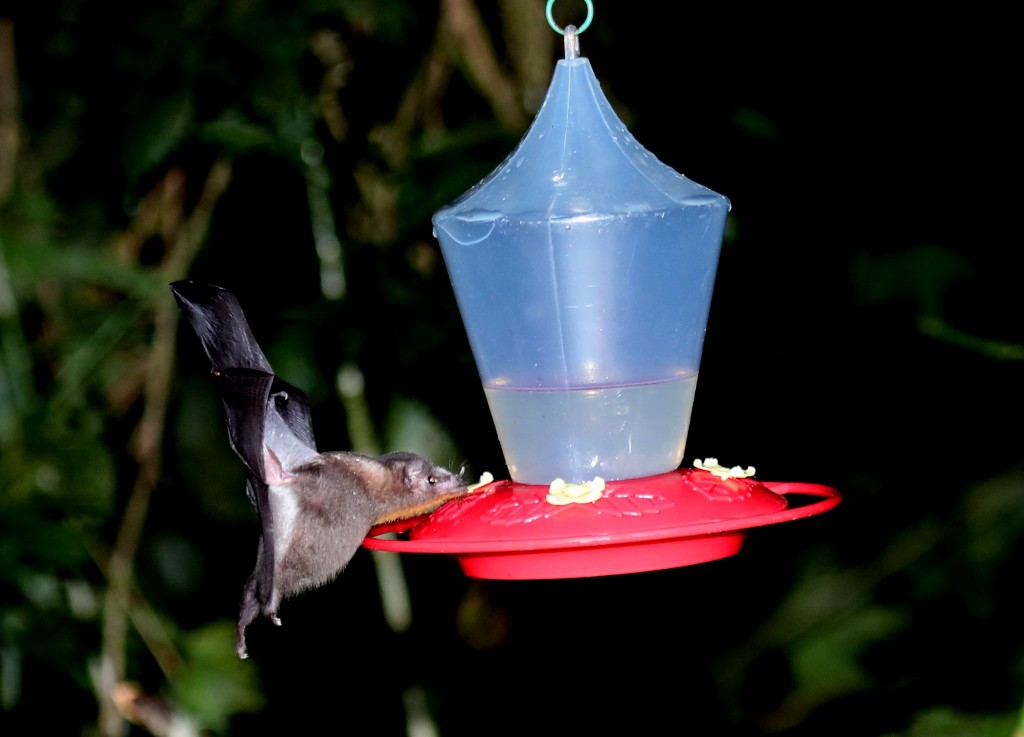
Tube-lipped Tailless Bats, Anoura fistulata. Photo by Alex Meyer.
Alex eventually saw one on a nectar-feeder close to midnight.
Papallacta
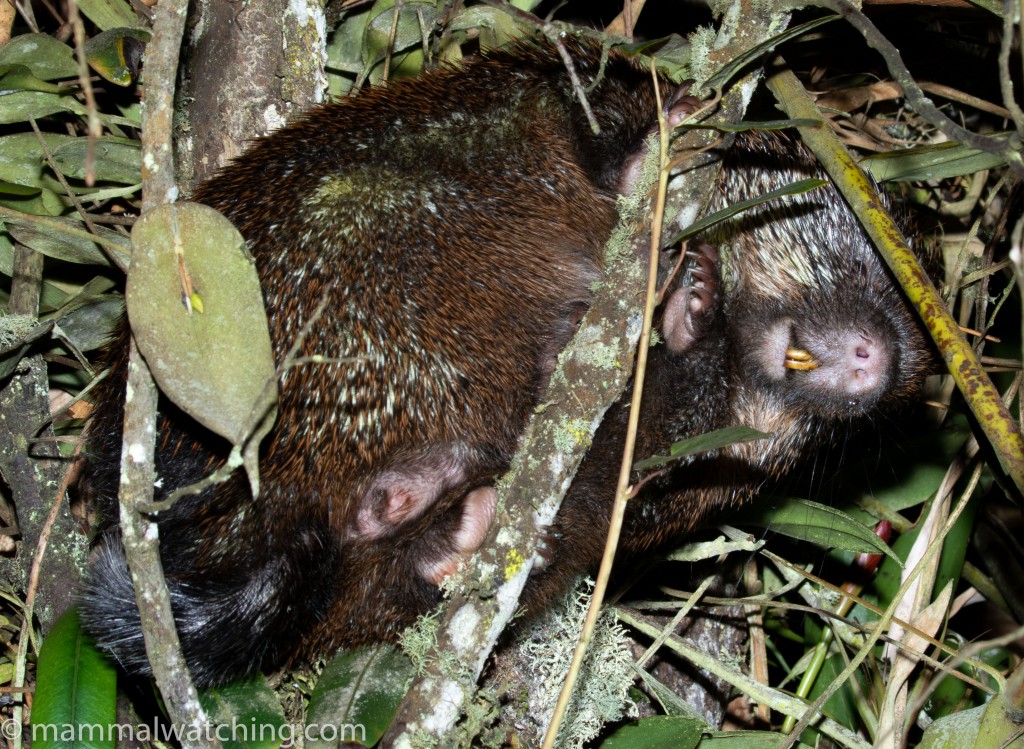
Stump-tailed Porcupine, Coendou rufescens
Coca Cayembe National Park is well known as one of the best places to see both Spectacled Bear and Mountain Tapir. I saw both here in 2012 along with Andean White-tailed Deer, Culpeo and Andean Cottontails.
Back in 2012 night drives were not on offer. But people are now able to enter the park at night and several recent reports mention the little known Stump-tailed Porcupine, while at least two reports have recorded Dusky Shrew-opossums on the roads at night.
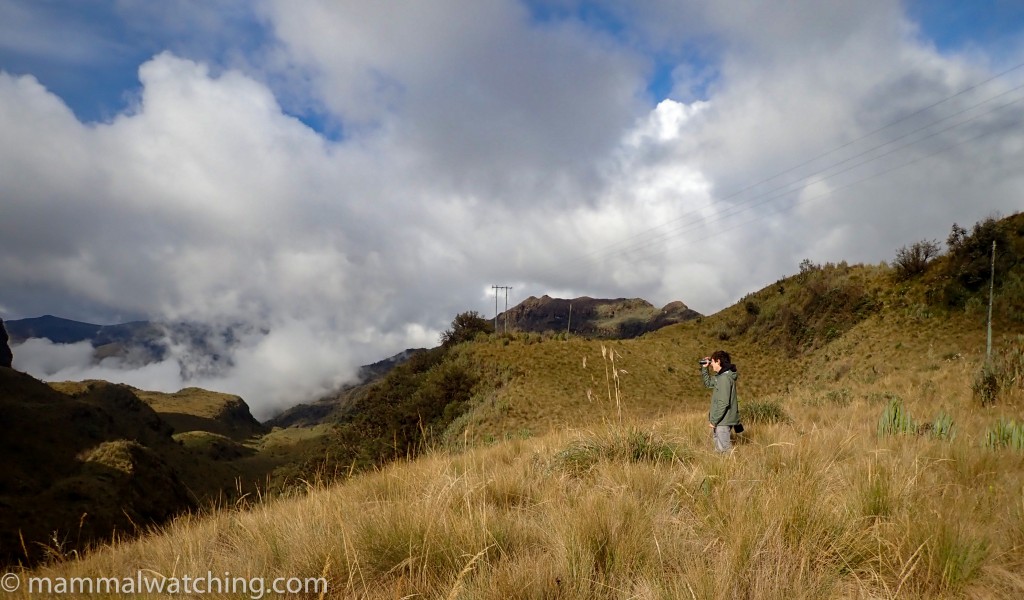
Alex looks for bears
My focus during our 24 hours in the park was on searching for these two species at night. We also spent an afternoon and morning drive looking for bears and tapirs and saw neither.
Jose spotted a bear as we were driving past the park on our way in from Quito. But we missed it. Ian Thomson saw one around here too. And Lisle Gwynn told me the first three km of the “old Quito road (turn left instead of right for the antennas)” is a good spot to try, especially with a thermal scope. Also a safe place to pull over than the main road.
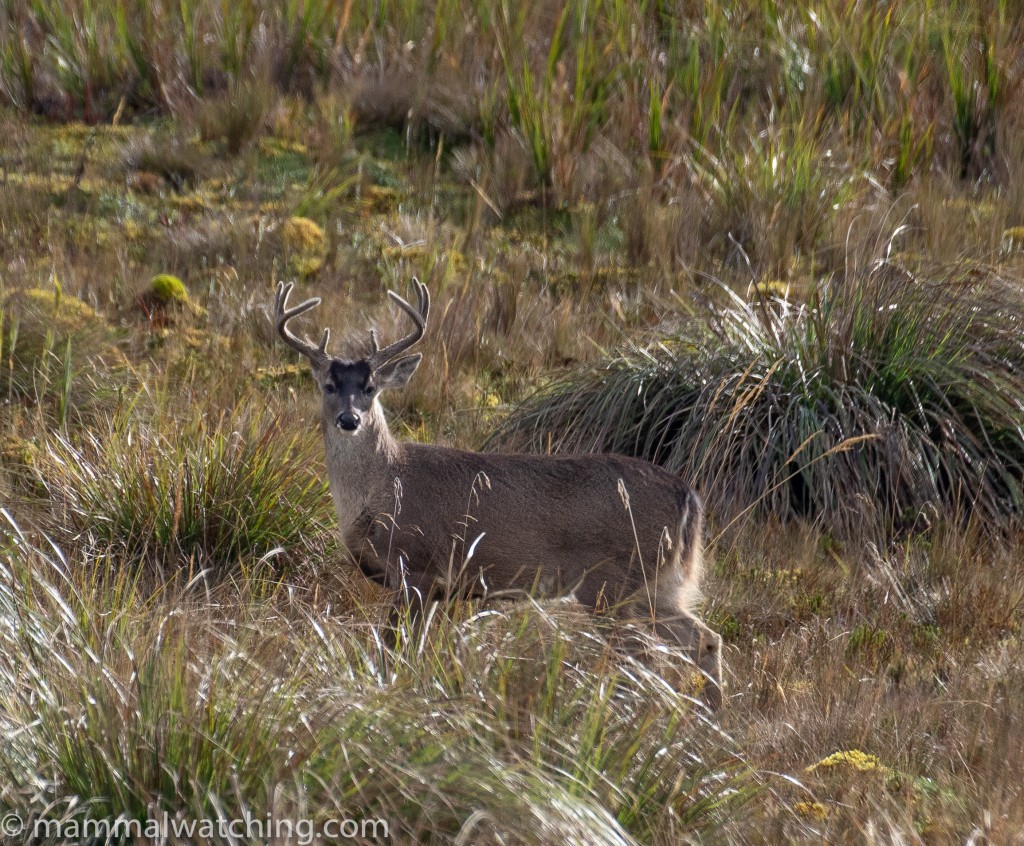
Andean White-tailed Deer, Odocoileus virginianus ustus
The only diurnal mammals were several of the distinctive Andean White-tailed Deer (which some believe are a distinct species O. ustus) and a couple of Andean Cottontails. Alex saw a Culpeo when he returned to the park the following week.
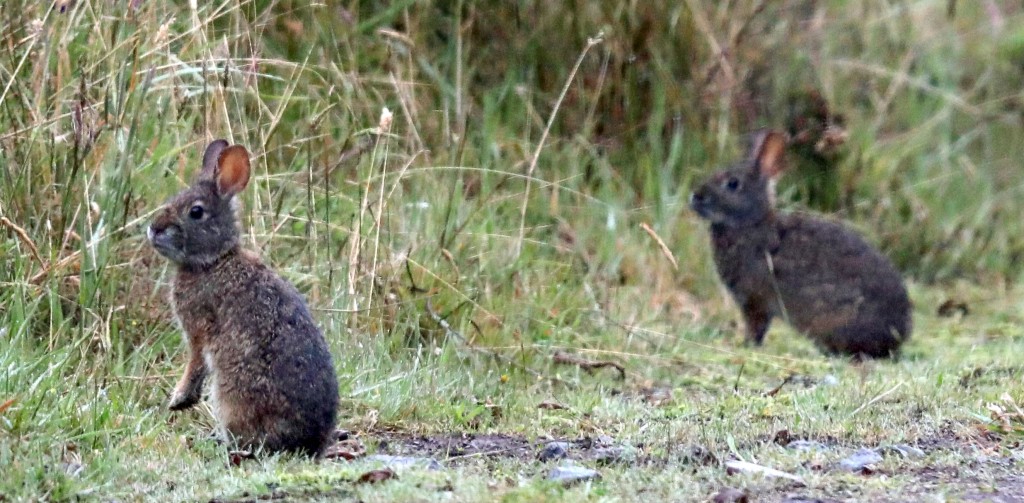
Andean Cottontail. Sylvilagus andinus. Photograph by Alex Meyer.
We used the parks go to guides, the brothers Mario and Patrizio Pillajo, to visit in the day and night. This proved somewhat complicated to set up, but in the end Adela from Jocotours spoke to them on the phone and smoothed things over.
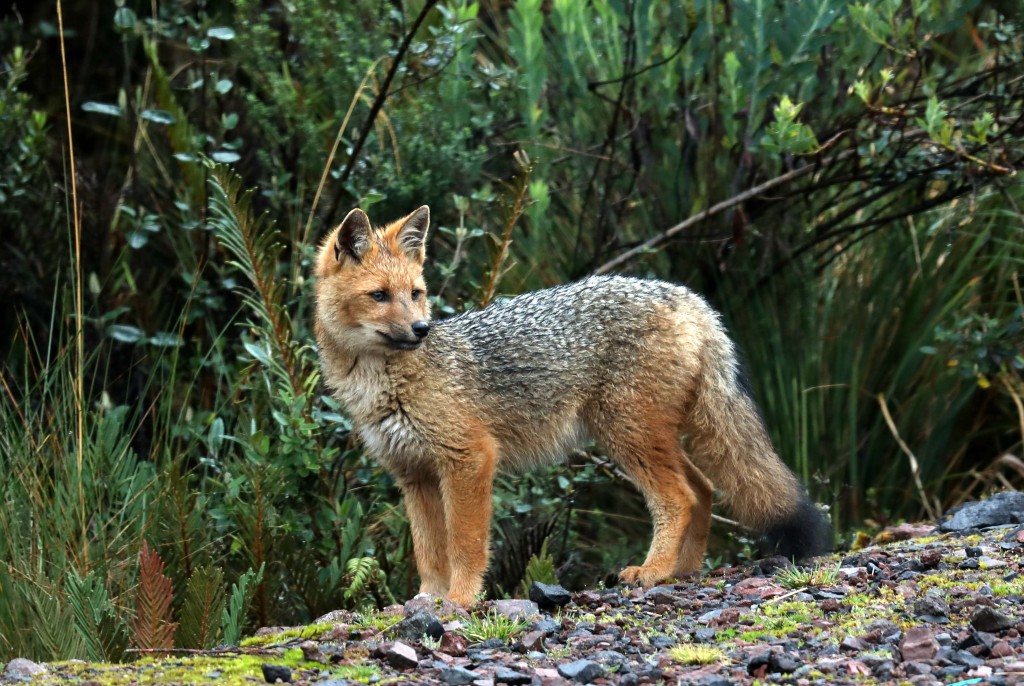
Culpeo, Lycalopex culpaeus. Photograph by Alex Meyer.
It proved even more complicated for Alex when he returned to the park after I had flown home.
Mario was optimistic we could see a Stump-tailed Porcupine. One is frequently seen by security guards at the Termas Hotel and Spa, moving across the car park. After dinner he gave the guards instructions to call if they saw it. During half an hour with our thermal scopes we couldn’t find a porcupine but I did see a colorful, bright orange/red rat in a tree right next to the door to the spa. There are very few rodents up this high and one candidate is Taczanowski’s Oldfield Mouse, Thomasomys taczanowskii. Alex saw it when he returned in the same tree and managed to get a very blurry picture that at least shows the bright color of the fur. If anyone has a better idea please let me know.
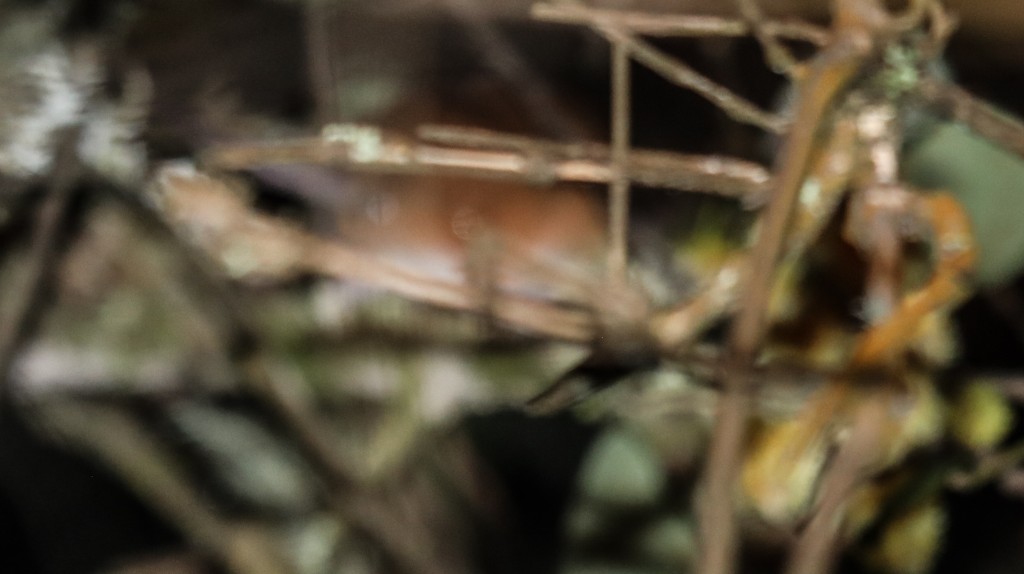
Possibly Taczanowski’s Oldfield Mouse, Thomasomys taczanowskii. Photograph by Alex Meyer.
When the porcupine failed to show Mario took us to a stream side trail a few minutes drive up the hill past the park gates a the Termas Hotel (from what I could gather these are the only gates that will open after dark).
The trail starts in very closed forest but after five minutes we passed a field and I saw something porcupine sized on the ground in my heat scope. Sure enough a Stump-tailed Porcupine which ran to the nearest small tree and froze several meters up. I love porcupines and this was the mammal of the trip for me.
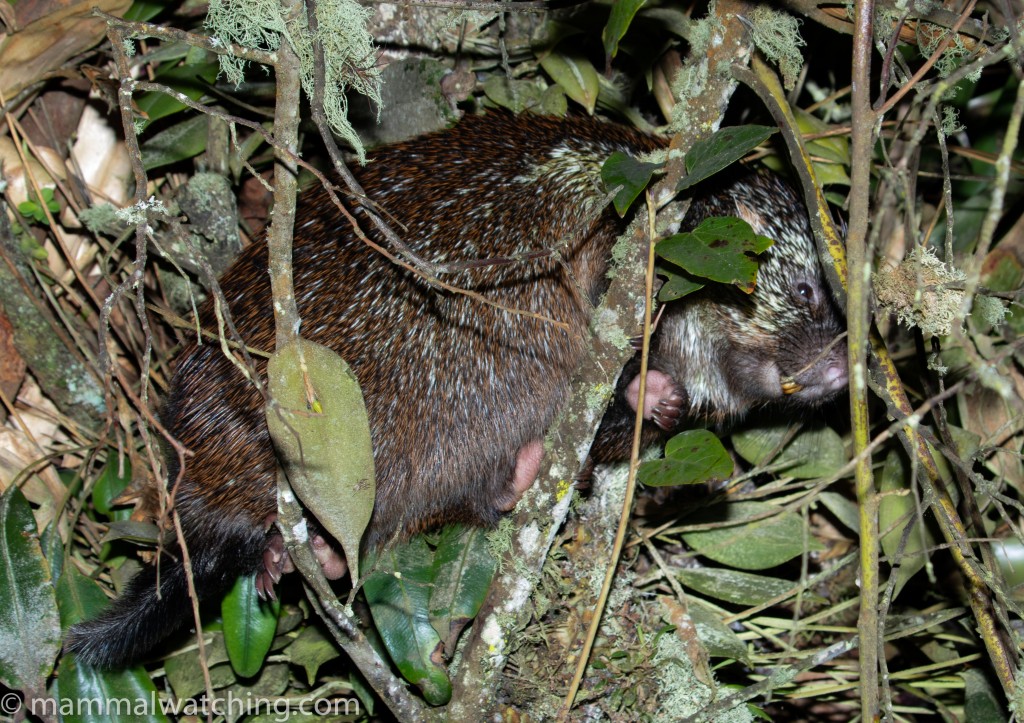
Stump-tailed Porcupine, Coendou rufescens
Although Mario was optimistic about seeing a porcupine he seemed pessimistic – or more accurately – bewildered at the idea of seeing a Dusky Shrew-opossum. He claimed never to have seen one.
I had already spoken to Armando Castellanos about shrew-opossums in Coca Cayembe. Armando is a scientist, head of the Andean Bear Conservation Foundation, and the man who had found me a Mountain Tapir back in 2012. He has spent a lot of time in the park and told me that though he has seen a few dead shrew-opossums along forest trails he has never seen a live one.
Now this was all very strange given Charles Hood and co had seen two small mammals on the park roads after dark that they understood Mario identified as shrew-opossums.
There is plenty of scope for confusion when speaking English with Mario but we did have Jose with us speaking Spanish and I was more than 90% sure we all understood each other at the end of the conversation more or less. So I cross-examined Charles and Phil Telfer (one of his companions on that trip) about their sightings and how they settled on an ID. They agreed that the glimpses they got of small mammals on the road were unidentifiable by them, and so they had relied on Mario. They couldn’t remember quite how Mario had explained they were shrew-opossums but were under the impression he believe them to be common.
Presumably some miscommunication was possible. None of this explains what species Charles and co did see that night.
Michael Kessler also reported seeing a shrew-opossum on the road at night in 2019. I also followed up with him and he too was helpful, letting me know that while he thinks he saw a shrew-opossum it was difficult to be 100% sure given the sighting was partially obscured by vegetation.
My take on all this is that if you want to see a shrew-opossum as much as I did then Coca Cayembe might not be the best place to look. Not that I know anywhere better yet, other than possibly Tapichalaca where Fiona Reid caught one in 2013.
Driving the park roads for an hour or two after dark produced no terrestrial mammals. We did see some bats close to the lower gate, possible Brazilian Freetails. We also saw two lighter colored, largish bats circling a strange – and rather pointless – lamppost up near 4000 meters in the middle of the park. On the basis of altitude I thought these might have been Small Big-eared Brown Bat (Histiotus montanus) which Diego Tirira’s book says are found at higher altitudes than other species in the country. But Diego wasn’t convinced, thinking they might be a myotis species. So I leave them unidentified and regretted not bringing my bat detector.
Alex tried valiantly to photograph them as they swooped into the light. But when his flash fired the lamp thought the sun had risen and turned off. End of photo shoot.
Guayango
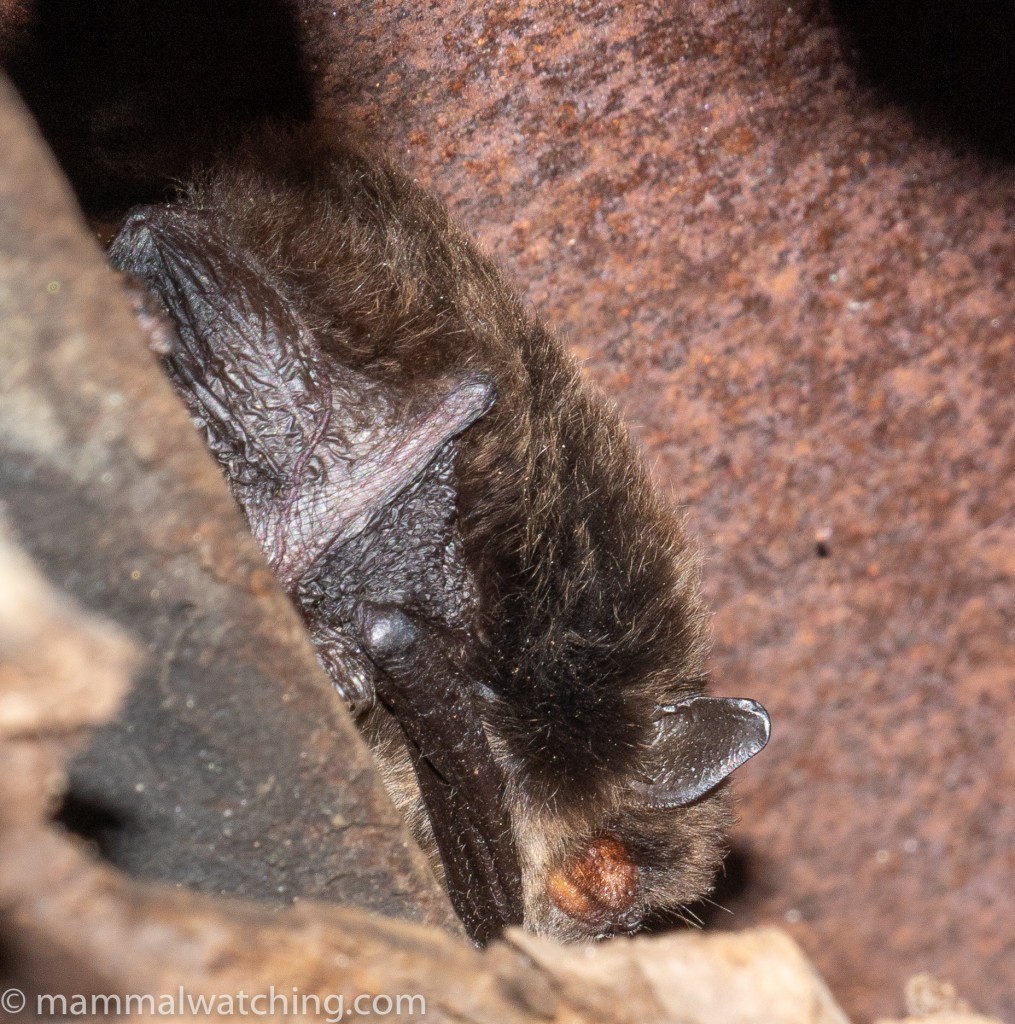
Montane Myotis, Myotis oxyotus
Guayango is an ecolodge half an hour down Papallacta on the road towards the Napo Valley. We stopped in here after a tip from Nils Bouillard that an abandoned house, 20 minutes walk from the lodge, was home to a colony of Montane Myotis, a species I had only seen once before and not well. There were dozens of them living under the decaying metal roof though it took a while before we could photograph one.
Cabanas San Isidro
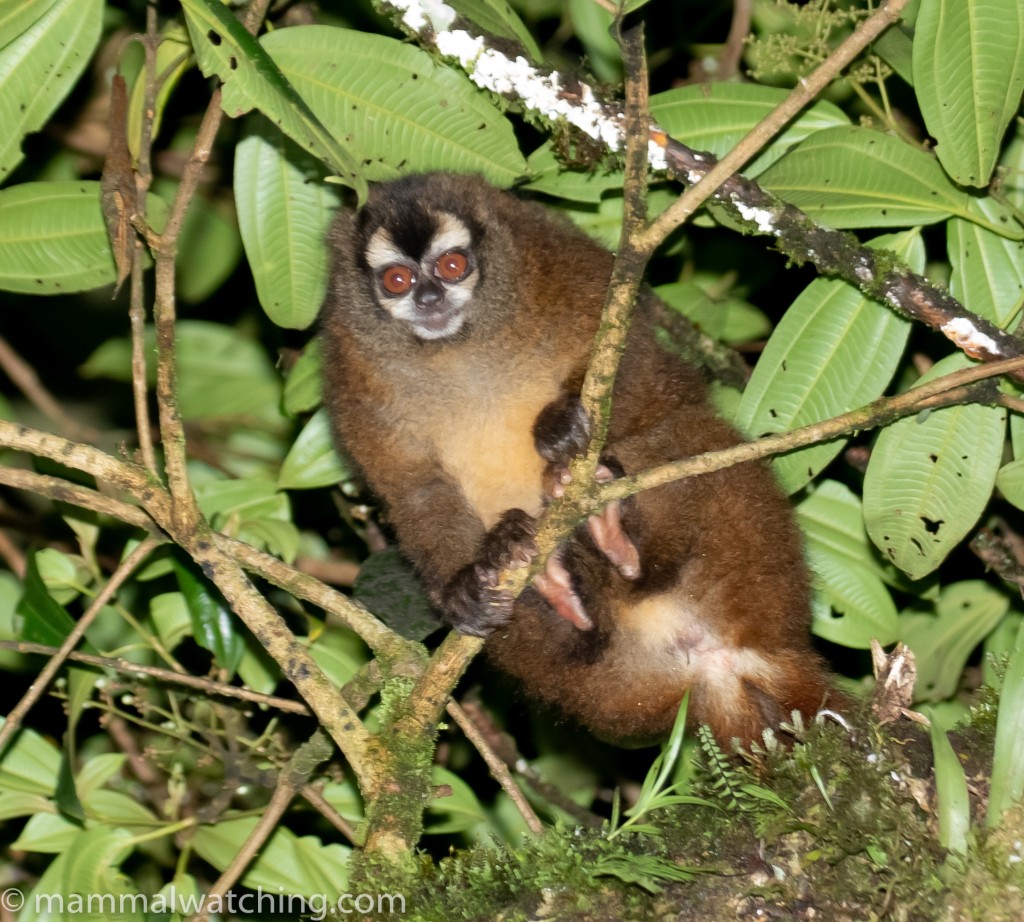
Grey-bellied Night Monkey, Aotus lemurinus
Our next stop was the wonderful Cabanas San Isidro, two hours from Papallacta. This is a beautiful lodge and we were the only guests there. The main target here were the Grey-bellied (Lemurine) Night Monkeys, and on Cheryl’s advice we allowed ourselves the luxury of two nights in the same place as the night monkeys were not guaranteed.
Like Cheryl we stayed in rooms 10 & 11 and, as she predicted, the night monkeys appeared both evenings on the dot of 6.30 p.m, emerging from trees tight behind our rooms. If only it was always so easy.
During the day Black Agoutis are easy to see around rice feeders just below the restaurant. And a Red-tailed Squirrel turned up at one point.
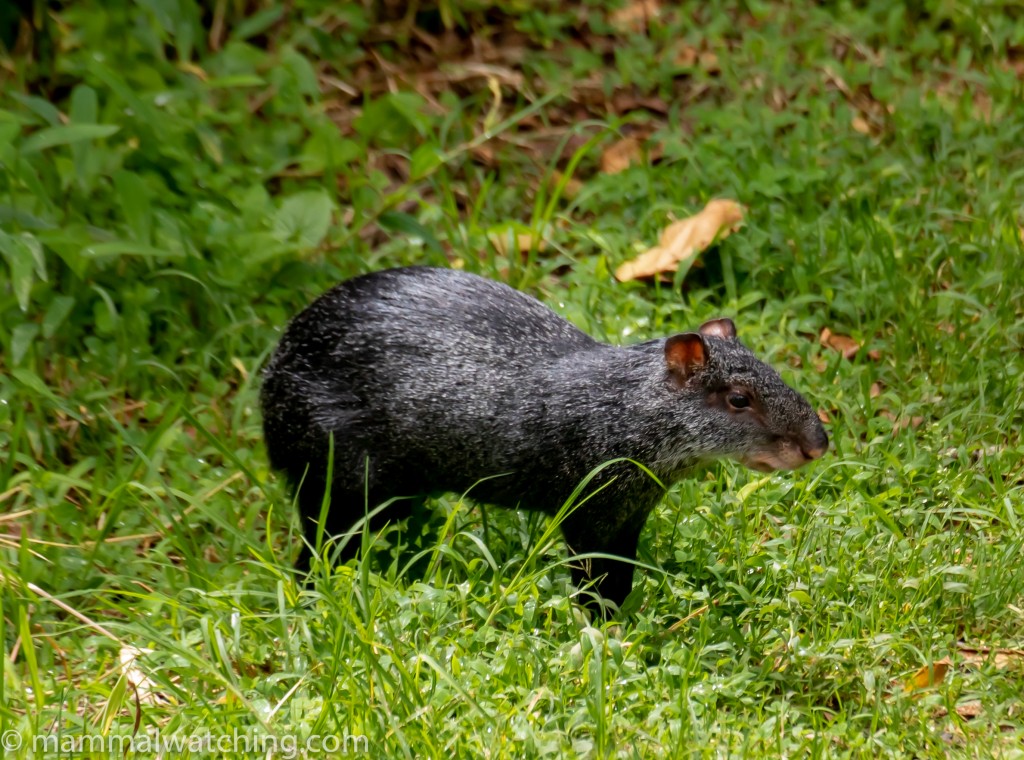
Black Agouti, Dasyprocta fuliginosa
But other mammals were scarce. I didn’t catch any rodents in 20 traps near the feeders, and there had been no sightings in the past week of the Mountain Tapir that occasionally visits the salt lick, nor the Oncilla that Cheryl just missed. Though there had also been very few guests. Without recent news it was difficult to know where to focus our efforts or how much effort to put in. The hammocks were also very comfortable …
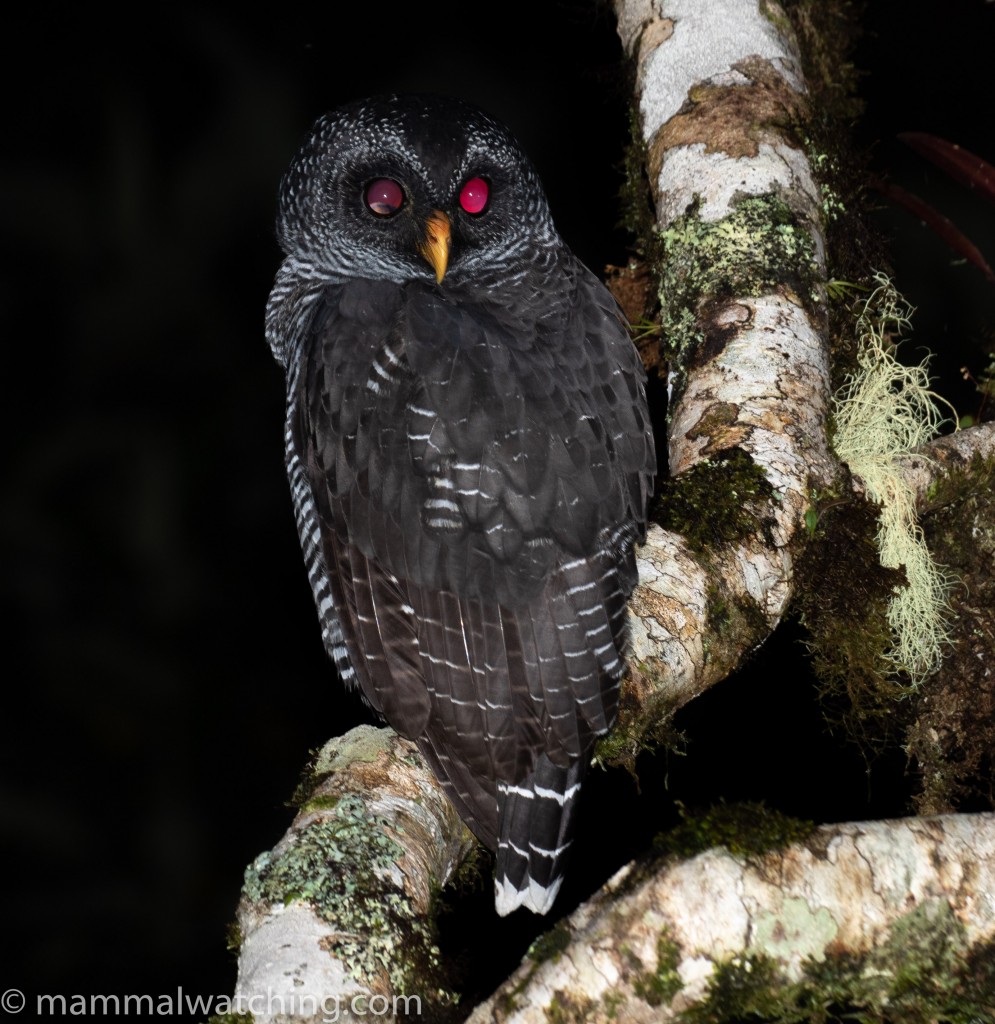
San Isidro Owl
The lodge is famous for the San Isidro Owl, a taxonomic puzzle that, I read, looks like a Black-banded Owl but sounds like a Black and White Owl. I don’t think anyone knows yet whether it is either species or something else entirely. But it was a nice looking bird and we saw several.
The lodge manager produced a mummified corpse of a small molossid bat, that came from a colony in the roof of one of the buildings. But after a long facebook conversation with Fiona Reid we decided it was just a Velvety Free-tailed Bat (Molossus molossus).
The only other mammal, besides bats flying along the trails, was a small to medium-sized arboreal rodent in a cecropia tree. It had a distinctive yellow-green sheen in the spotlight and I am still trying to see if we can figure it out. Because the lodge is up at around 2000 meters there are relatively few options.
Napo Wildlife Centre
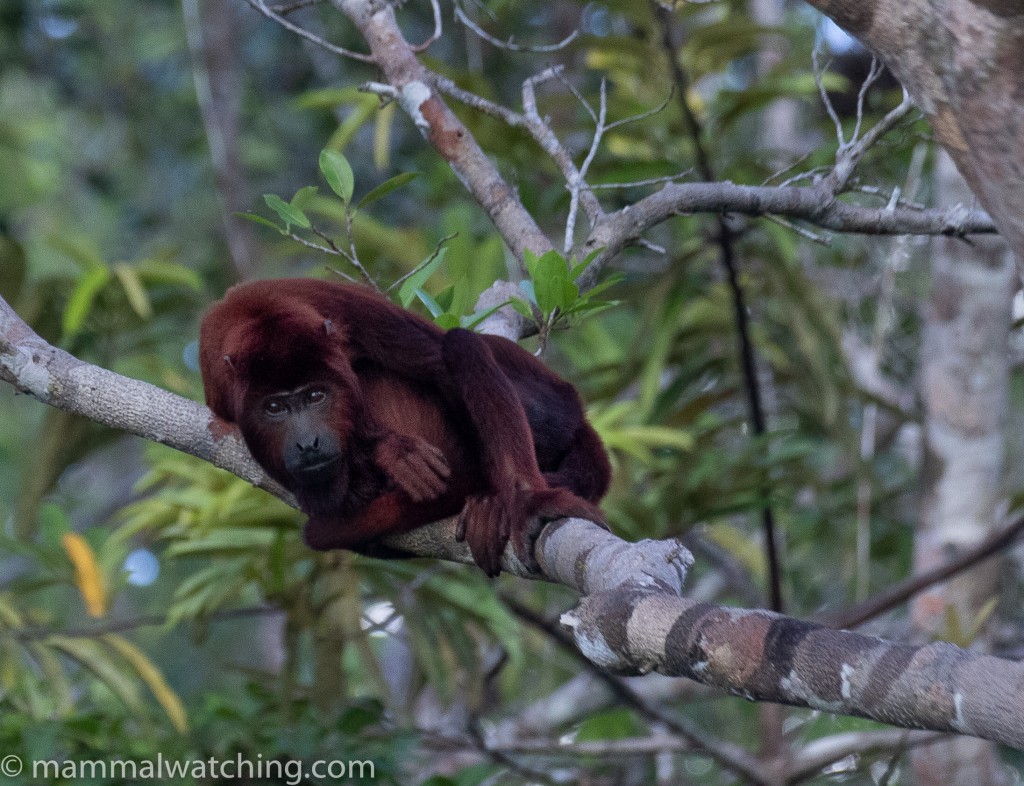
Venezuelan Red Howler Monkey, Alouatta seniculus
Our last stop of the week was three nights at the Napo Wildlife Centre (NWC). Most visitors buy a package to visit the NWC which includes flights from Quito and Coca, from where you take a 4 hour boat ride to the lodge. It made more sense for us to drive to Coca (about 3 hours from San Isidro) though we flew back to Quito at the end of the stay.
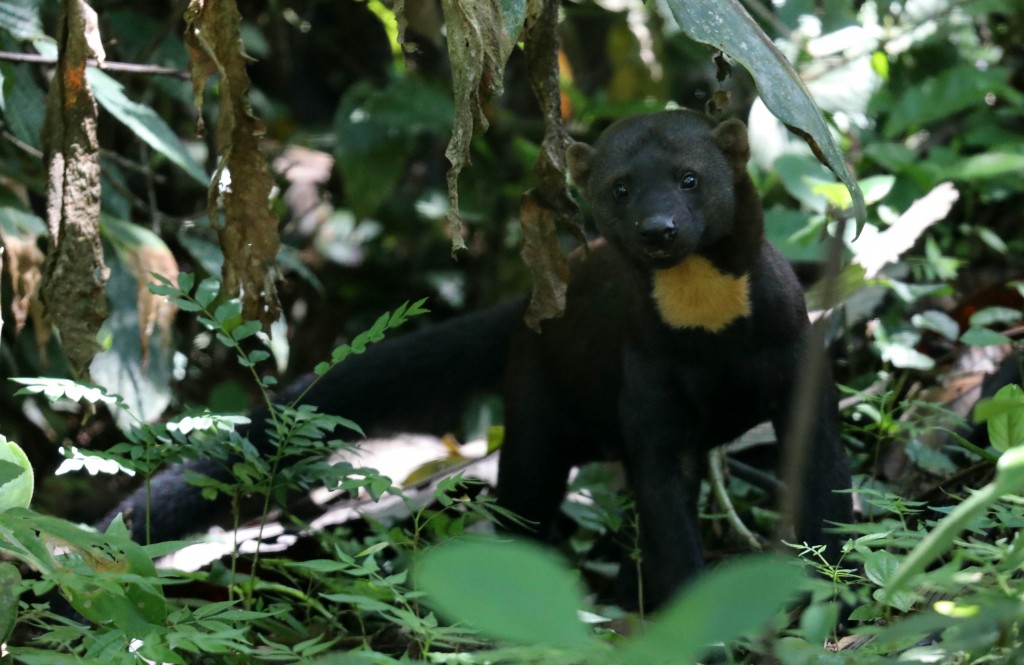
Tayra, Eira barbara. Photo by Alex Meyer.
The lodge is generally expensive but, because of COVID, they were offering significant discounts. It was still expensive.
Back in 2012 I had stayed at Sacha Lodge on the other side of the Napo River. I chose the NWC this time because it is an excellent place to see White-bellied Spider Monkeys and Napo Monk Sakis, neither of which I’d seen. There is also a very very slim chance for Bush Dog here.
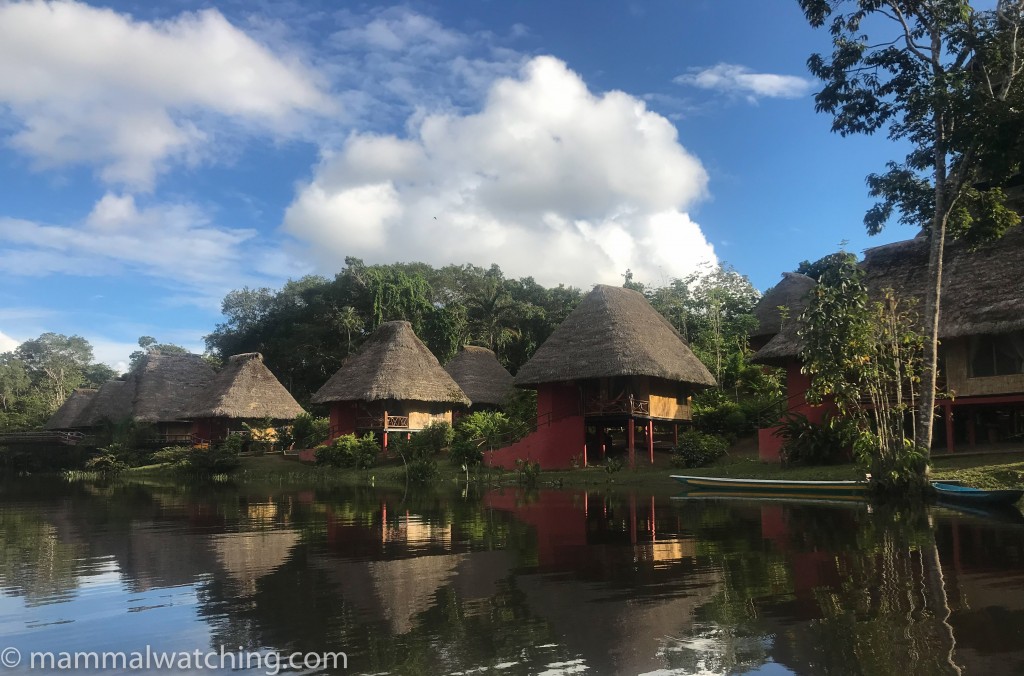
I feared it might be a very touristy lodge, focussed less on the wildlife and more on a “genuine”Amazon experience. I was wrong and I loved the place.
First, it was one of the most efficienty run operations I have ever stayed at.
Second, the guides – all Indigenous – seem exceptionally good at spotting stuff (more on this later).
Third, the lodge has an interesting story. It is owned and run by a local Indian community. After they opened they agreed to stop hunting in the area and so the lodge has become a positive force for conservation. As a result the wildlife is extremely approachable an I don’t remember seeing monkeys so relaxed.
Fourth, they make great caipirinhas.
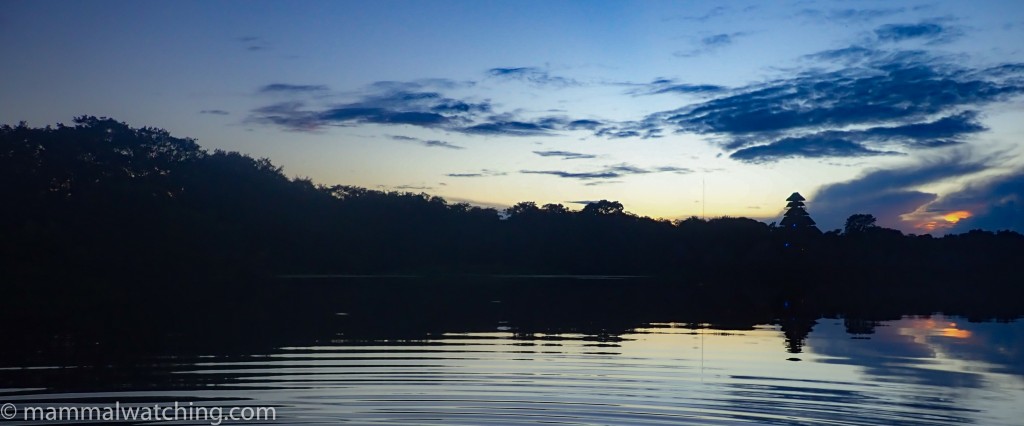
The lodge is beautiful, on the edge of an oxbow lake frequented by Giant Otters and many species of primate. Its almost entirely constructed using traditional materials and methods. Except for the elevator that runs … well crawls … up the viewing tower in the middle of the lodge! I took it once to try it out. It was quicker – and much more relaxing to walk.
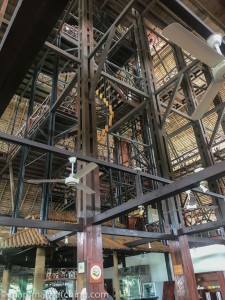
A traditional Indigenous elevator
There were quite a lot of visitors staying here, at least compared to the other places we had visited. Most were divided into two groups, each sharing a guide. Alex and I payed extra to have a private guide so we could focus on the mammals and not get taken for day trips to visit the parrot clay lick or the local community. I did not regret this.
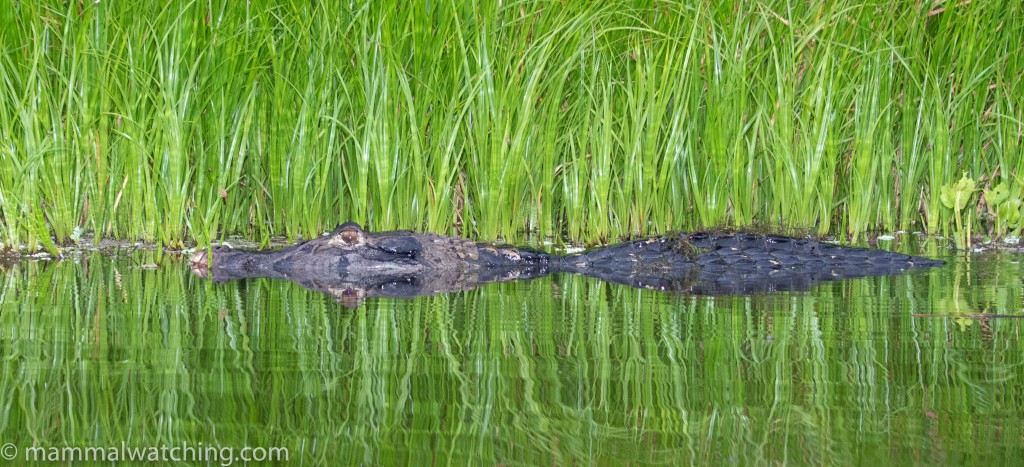
Black Caiman
Our guide – Delfin – was exceptional. It has been a very long time since I was with someone so adept at spotting stuff. He’d grown up in an Indigenous community in southern Ecuador, hunting in the forest with his family. He saw things long before we did.
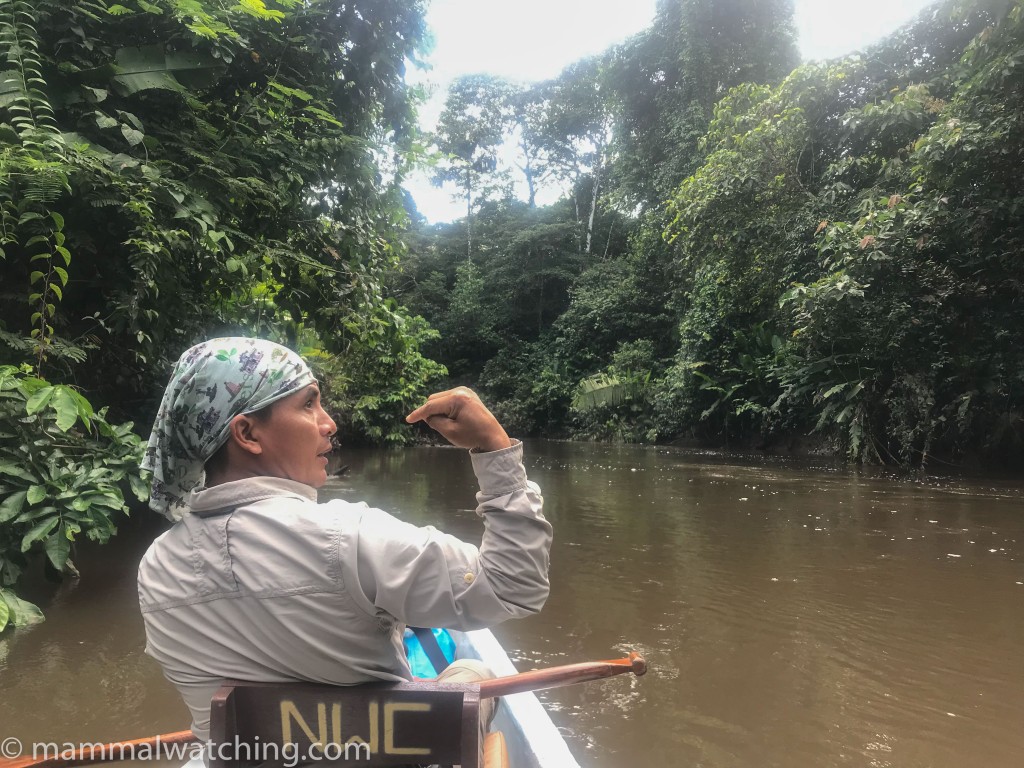
Delfin
I spent time failing to impress him with the magical powers of my thermal scope. The conversation generally went something like:
“Hey Delfin, there are monkeys ahead”, I said proudly.
“Yes”, replied Delfin, politely but without much interest, still looking in the other direction, “they are Squirrel Monkeys”.
He also knew all the calls. And after hearing Giant Otters one morning was able to figure out exactly where they had swam off to in the flooded forest.
We spent most of our three days looking for Napo Monk Sakis and Delfin remained completely committed to our mission.

We did nearly all our mammalwatching by canoe.
There are a few trails in the forest as well as a 3o metre canopy tower in the forest (no elevator here) that we visited briefly. A short trail behind the lodge is used for night walks. We walked it once at night and saw a couple of Kinkajous and Delfin also saw a Paca. All other trails can only be accessed after a canoe ride. We got permission to take a night trip on the canoe, something that is not usually encouraged because of the many Black Caimans. We saw nothing. I don’t know why.
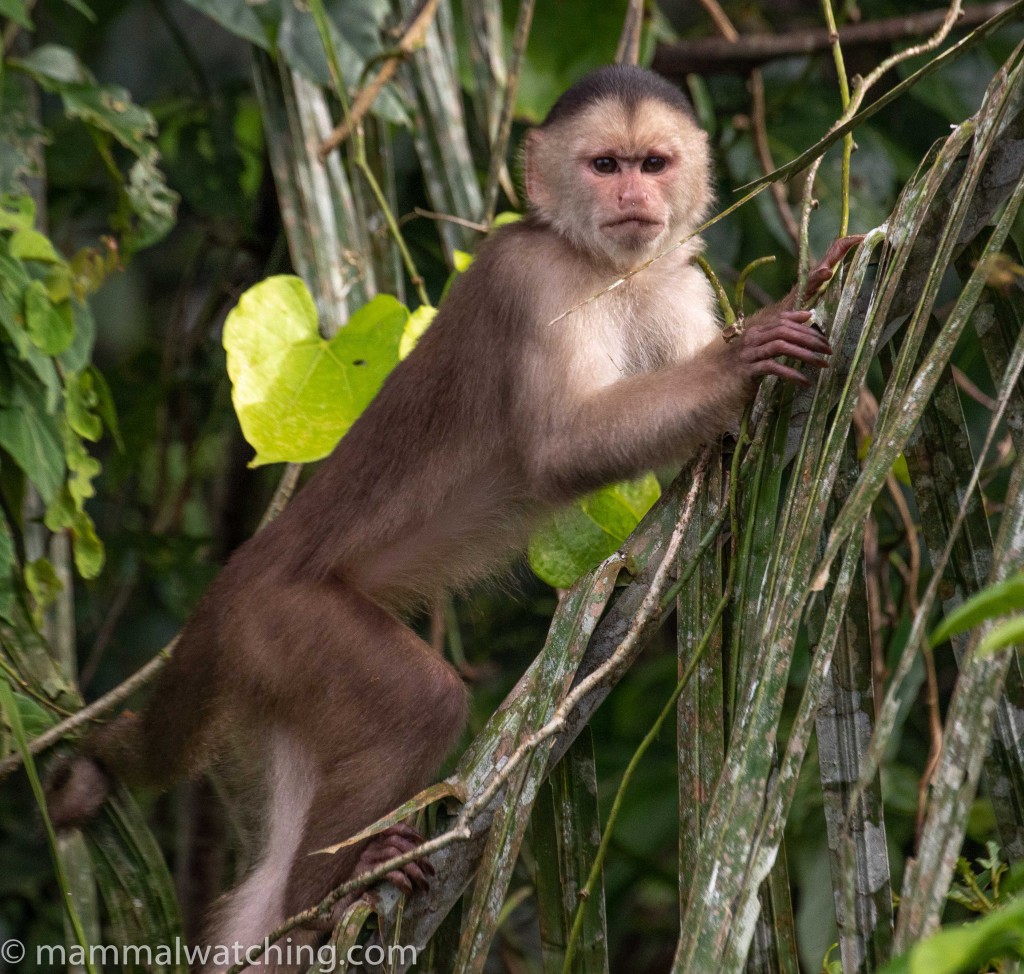
Marañó White-fronted Capuchin, Cebus yuracus
We had 2.5 days around the lodge to look for mammals. We took to the canoe very early each morning, and again in the mid afternoons. We did one night walk behind the lodge and another night canoe paddle. On our last evening heavy rain stopped play.
The NWC is a great spot for primates. White-faced Capuchins, Red Howlers and Ecuadorean Squirrel Monkeys are all very common. We saw them on every outing.
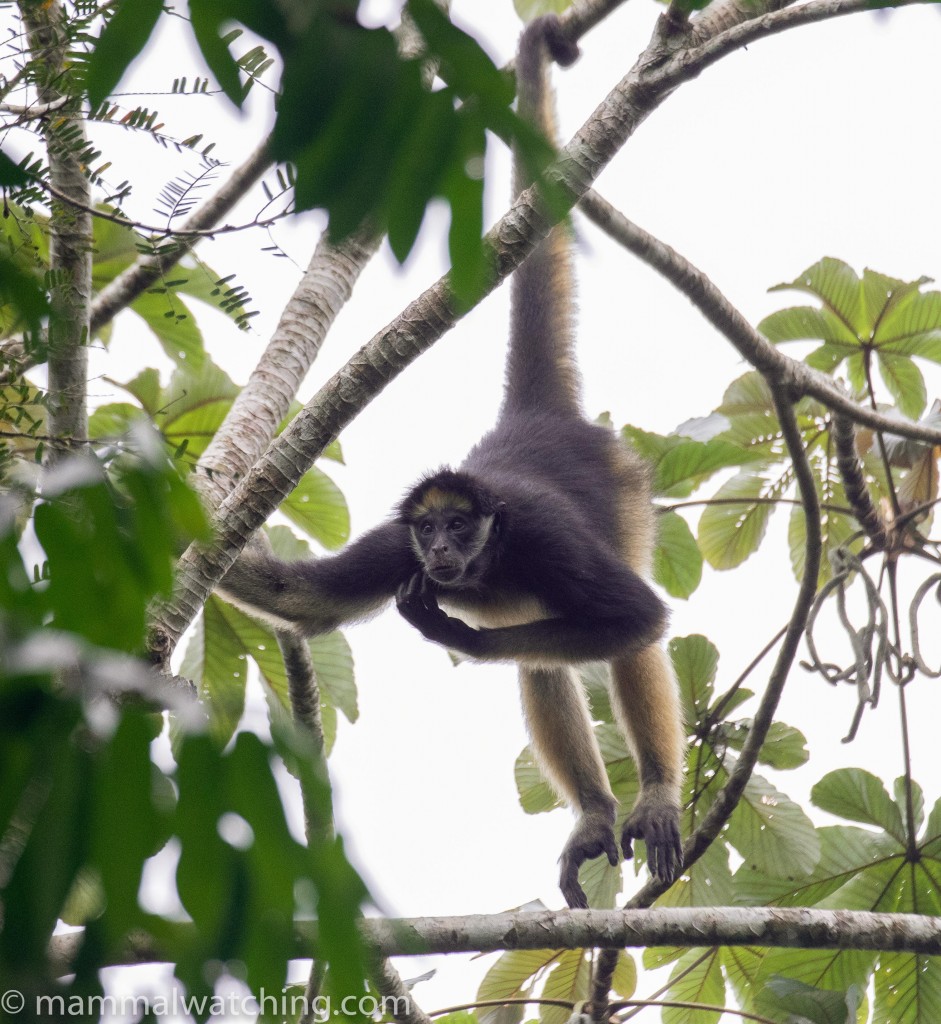
White-bellied Spider Monkey, Ateles belzebuth
The White-bellied (aka Long haired) Spider Monkeys are one of the speciality mammals here. They too were quite easy to see, and we saw them on most if not all trips. This was my last unticked spider monkey so it was satisfying to get the set.
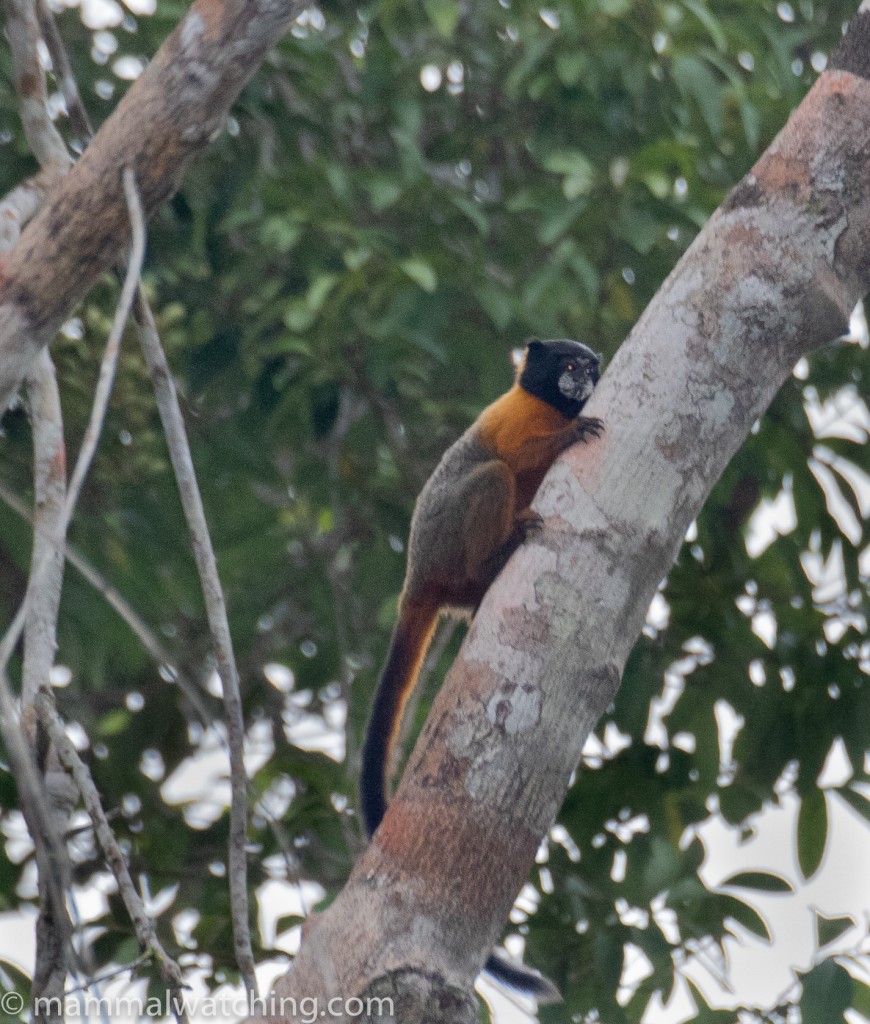
Golden-mantled Tamarin, Leontocebus tripartitus
Golden-mantled Tamarins are another specialty species, found only on this side of the river. We saw them only once, right in front of the lodge where they are often seen. Had we wanted to see more I imagine we could have tracked them down.
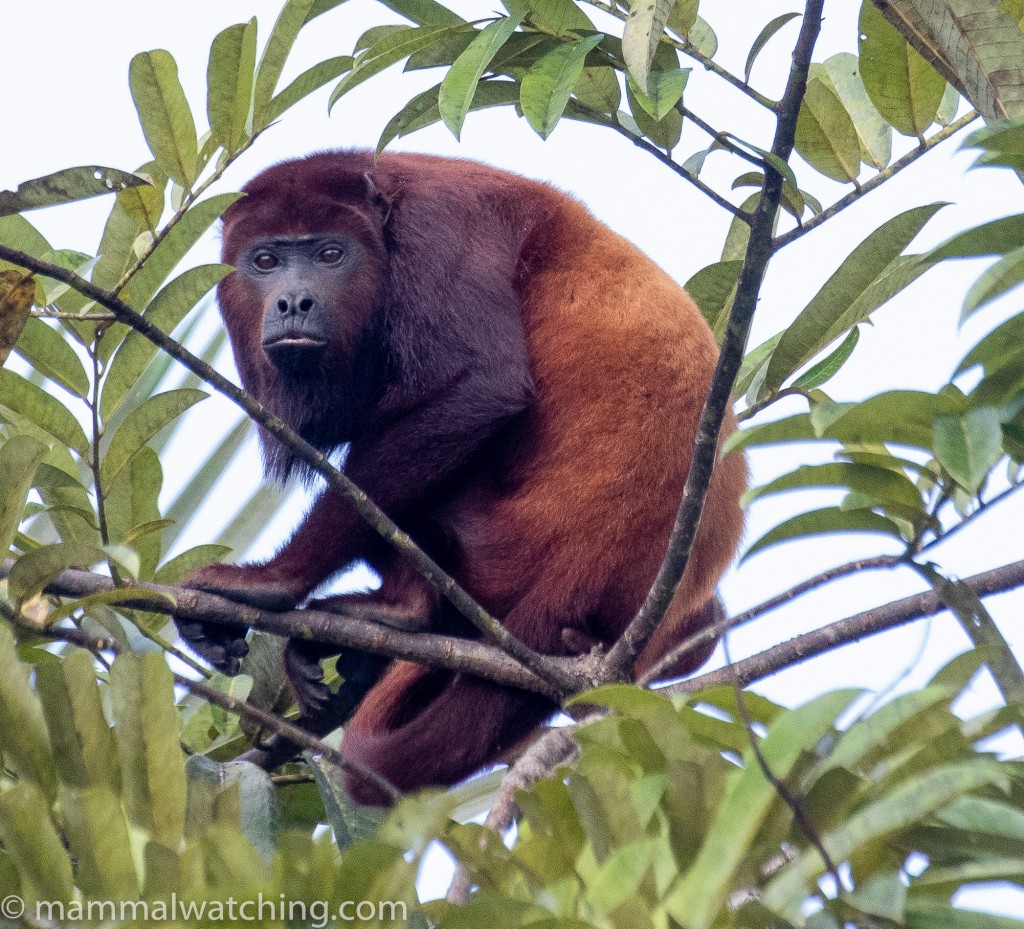
Venezuelan Red Howler Monkey, Alouatta seniculus
All of the monkeys we saw were somewhere behaving somewhere between relaxed and “what have they been smoking?”. Really lovely to see.
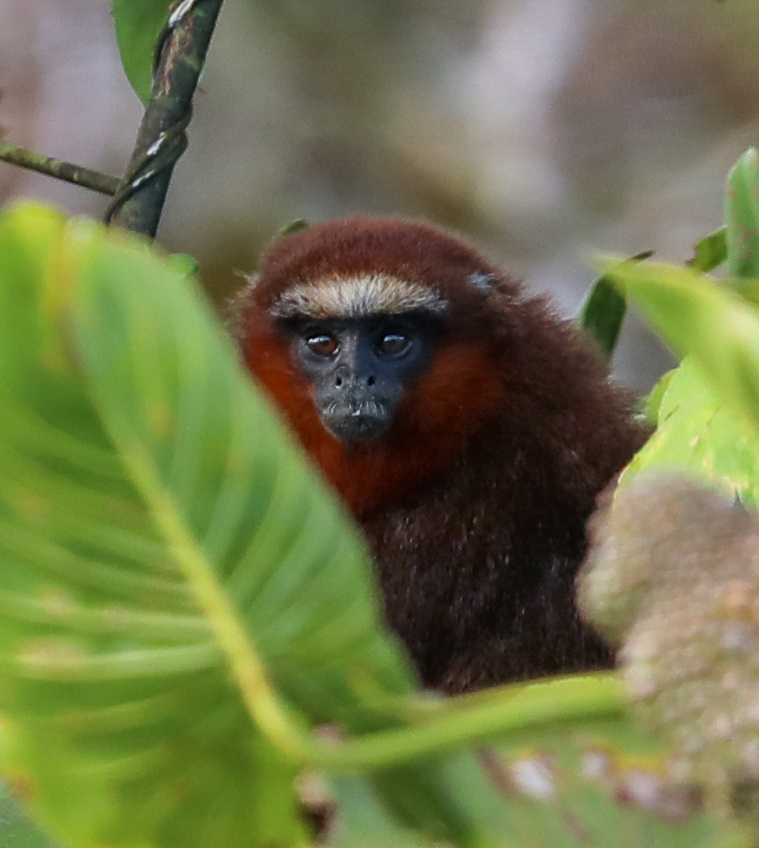
White-tailed Titi Monkey, Plecturocebus discolor. Photograph by Alex Meyer.
This White-tailed Titi was the most unusual primate sighting of the trip according to Delfin. Though the monkeys were once often seen close to the lodge it had been many months since he had seen them. He thought an Anaconda had disposed of the family that used to live in the area.
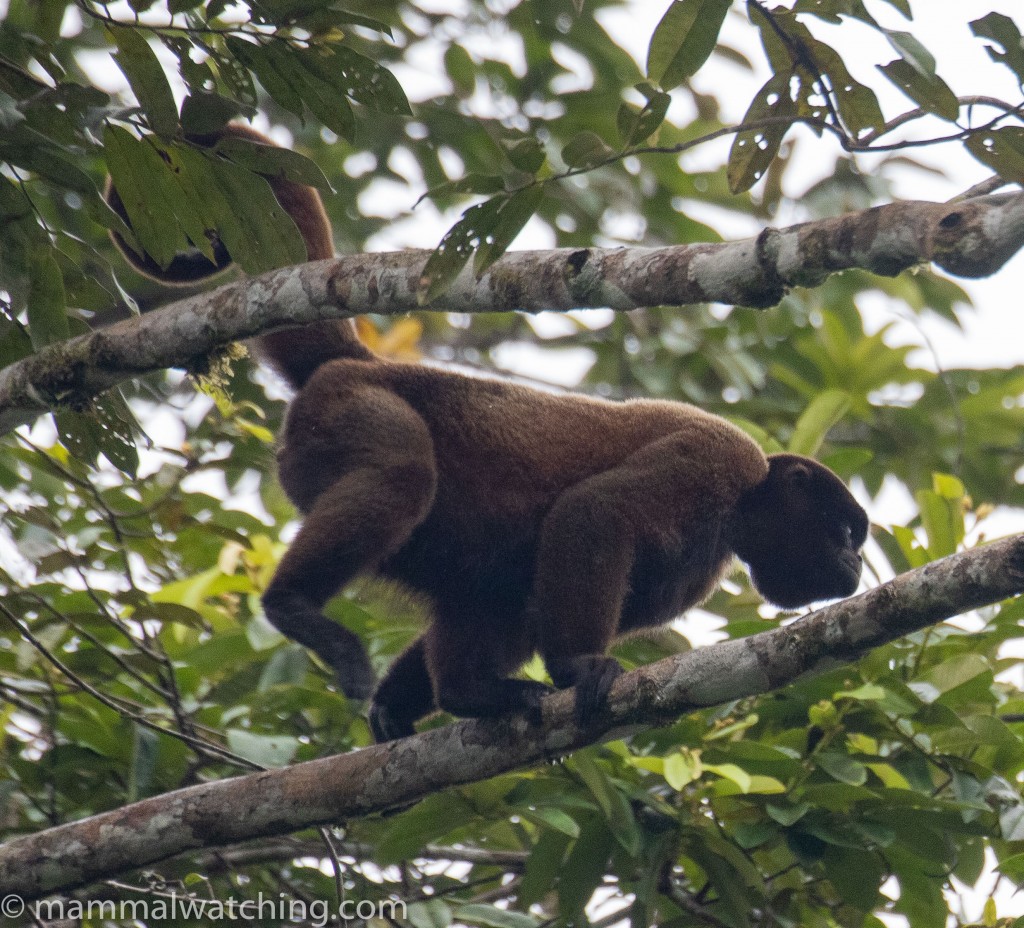
Common Woolly Monkey, Lagothrix lagothricha
Even the Woolly Monkeys, that usually flee at the first sign of Homo sapiens, were very confiding.
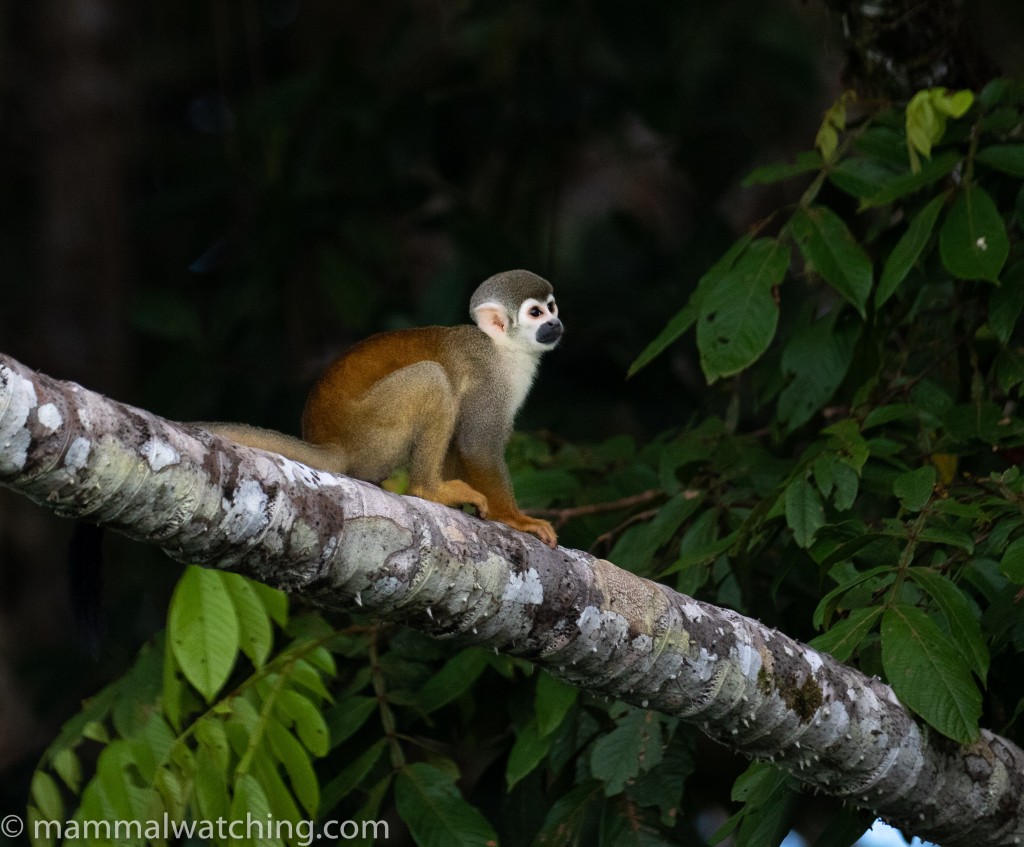
Ecuadorean Squirrel Monkey, Saimiri macrodon
The NWC website claims there are 11 species of primate around the lodge. We saw eight. Delfin said that the Spix’s Night Monkeys were no longer easy to find after their roost tree near the lodge had fallen over. He also said it had also been a long time since he had seen Pygmy Marmosets. So we didn’t make any effort to look for either. The mathematically gifted will realize this is only ten primates. I do not know what the 11th one is. Either this is a mistake or they are referring to the Black-mantled Tamarins on the other side of the Napo River.
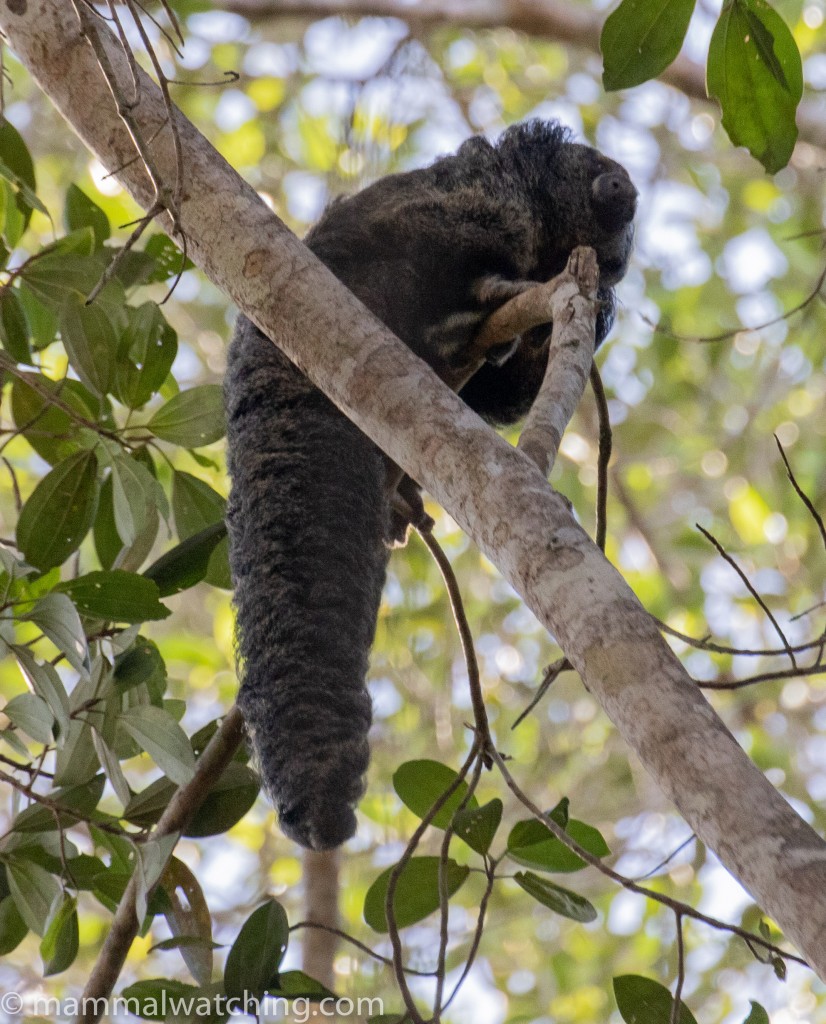
Napo Saki, Pithecia napensis
We struggled to see a Napo Saki. This recent – and still a little dubious – split from Monk Saki ought to be easy along the stretch of creek through flooded forest that begins about 20 minutes from the lodge. We spent hours paddling up and down that creek, seeing seven other diurnal primate species. Delfin was surprised.
But on our last afternoon he got a message over the radio that another group had just seen them, so we dashed to the canoes and Delfin and our boatman paddled like there was an Olympic Gold up for grabs. We got to the spot in 20 minutes and sure enough a family group were very discretely lounging in a tree right over the water. Had we not known they were there even the legendary Delfin might have paddled straight past.
They are extraordinary looking things. When my son, then 14, saw a Red Uakari he described it as a “Russian Mafia Monkey”: bald head, fur coat and attitude. If Sakis are not in the Russian mafia then they must, at least, be senior members of the Ukranian underworld.
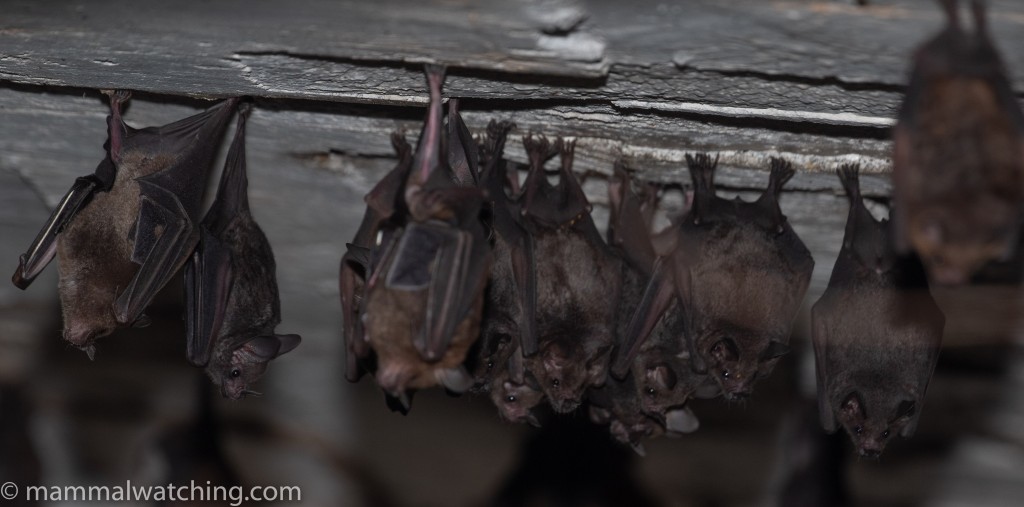
Seba’s Short-tailed Bat, Carollia perspicillata
Alex had more energy than I did to go looking for bats. So I let him. He discovered a couple of roosts under the dining area: walk up the path with the restaurant on your right and you will pass a couple of covered spaces underneath the dining room. There were at least three species roosting here.
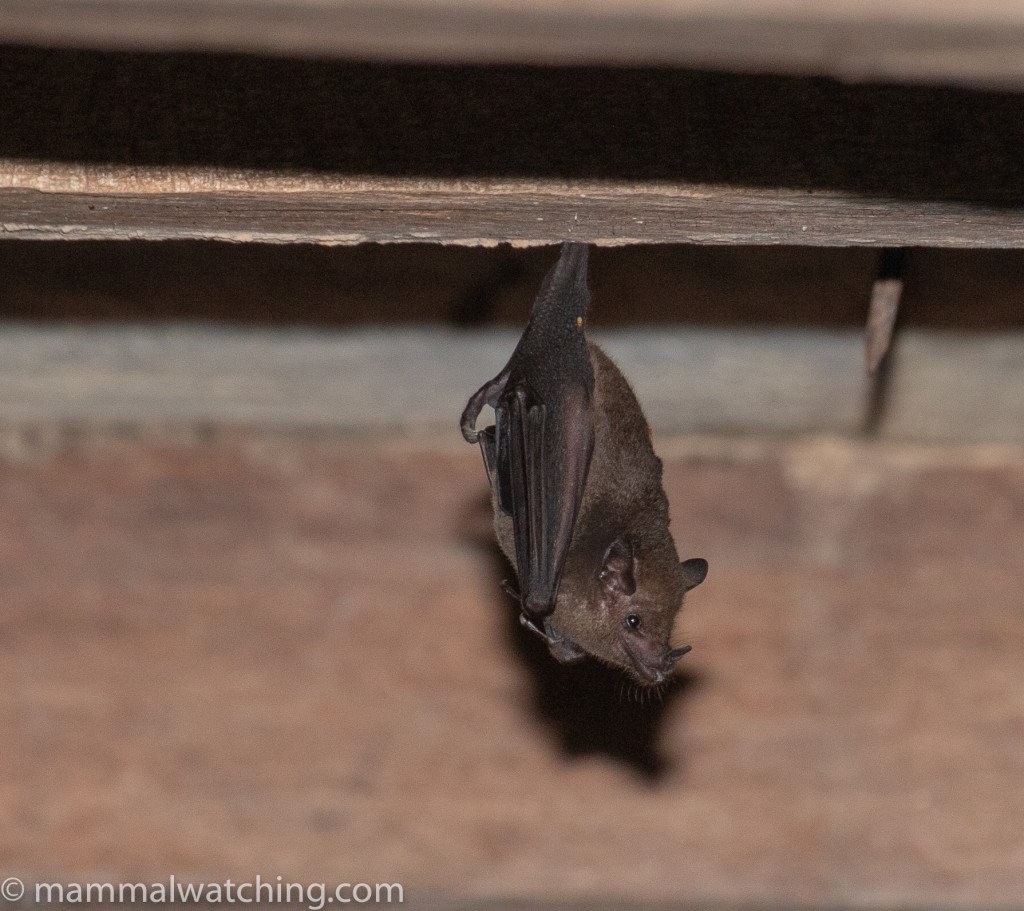
Common Long-tongued Bat, Glossophaga soricina
There were many short-tailed carollia bats, probably Carollia perspicillata. A lone long-tongued glossophaga bat, probably Glossophaga soricina.
More intersting were a few of the cool and very warty Fringe-lipped Bats. (Thank you to Fiona Reid for confirming the IDs).
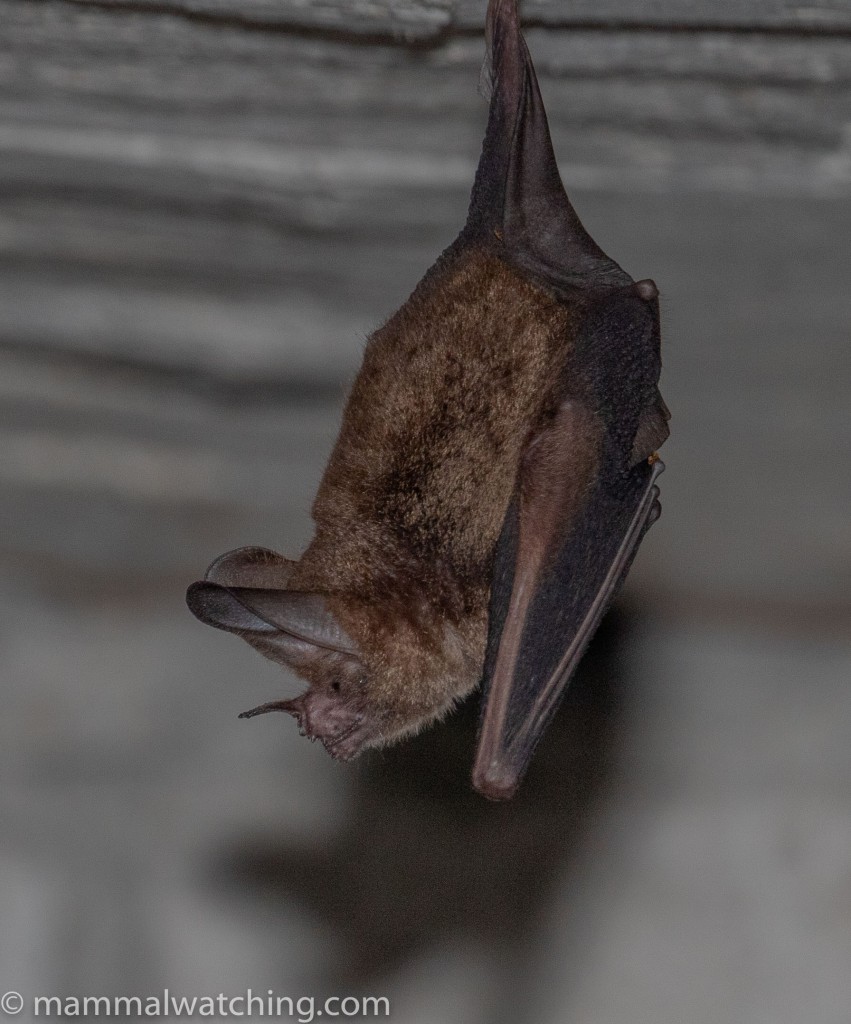
Fringe-lipped Bat, Trachops cirrhosus
Alex also found a large bat at night hanhing high up under the roof over the boat dock: a Greater Spear-nosed Bat.
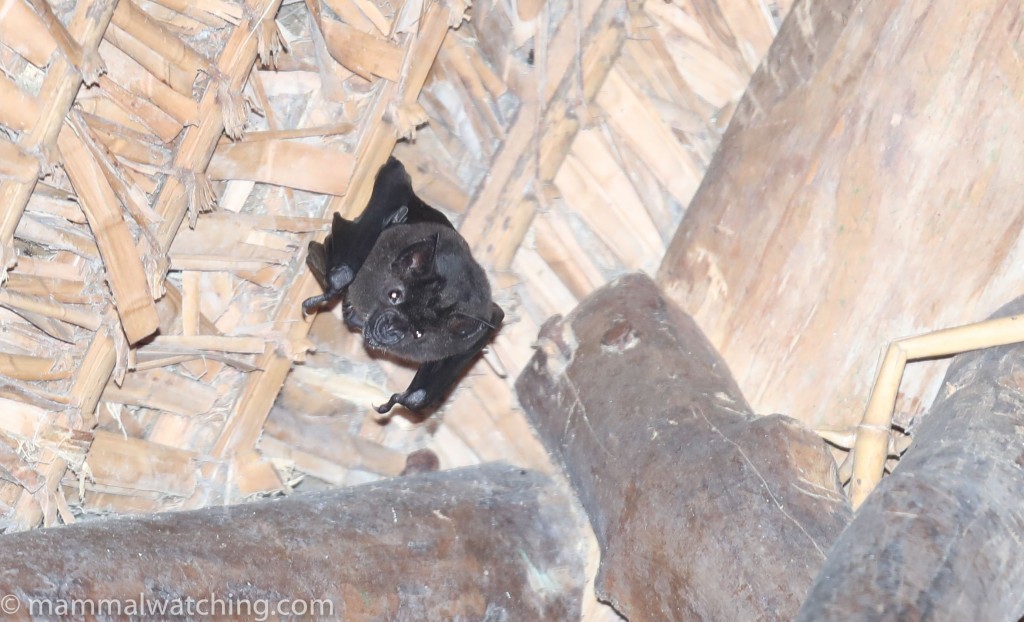
Greater Spear-nosed Bat, Phyllostomus hastatus. Photograph by Alex Meyer.
Other than a few Lesser Fishing Bats flying over the river the only other bats we identified were Long-nosed (Proboscis) Bats. There were many under the lodge boardwalk and roosting along the river.
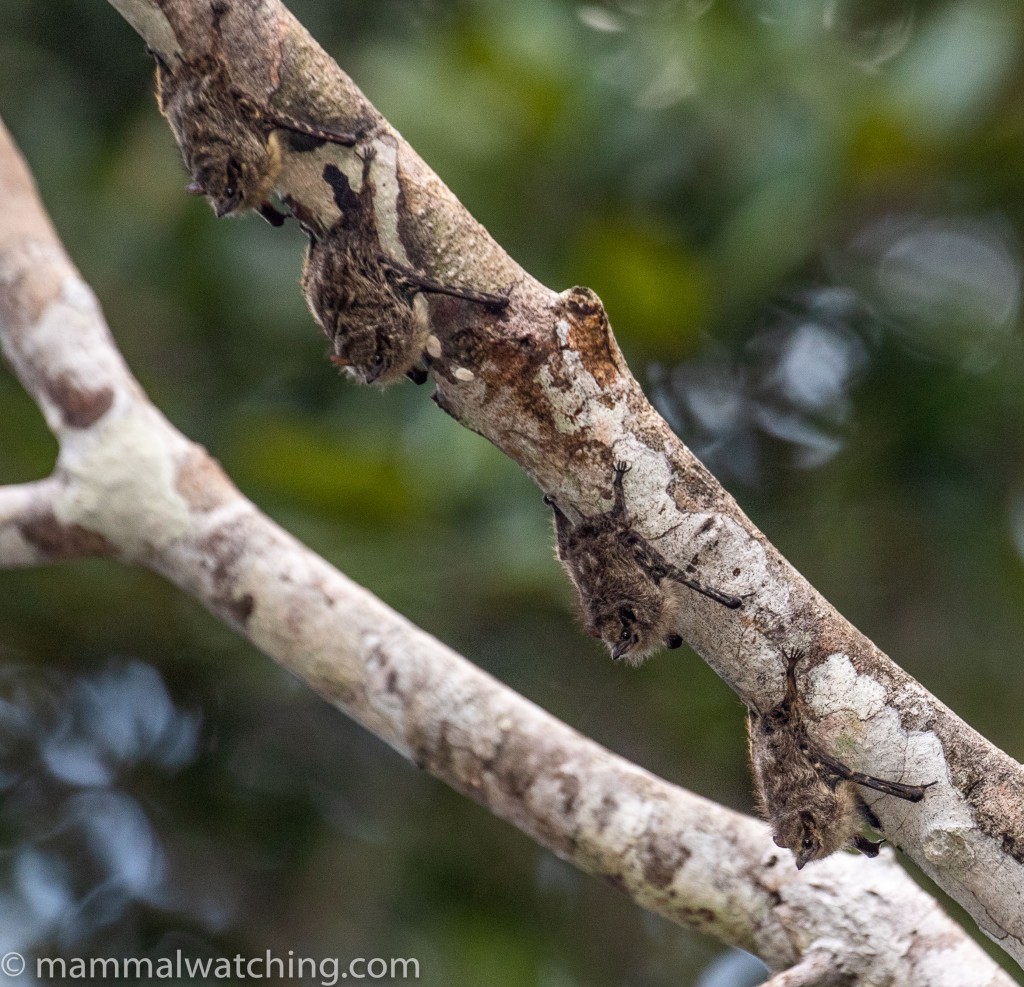
Proboscis Bat, Rhynchonycteris naso
I was so preoccupied with saki spotting that we didn’t focus on anything else. There was a chance of Green Agouchy along one or two trails that we walked but we didn’t see any.

The only other mammals were a Tayra that is often seen close to the restaurant. Alex saw it at midday at the start of the “night walk” trail. I saw it at 6.30am the next morning after I glanced down from the restaurant. We also saw a Hoffman’s Two-toed Sloth hanging over the creek and a resident family of Giant Otters.
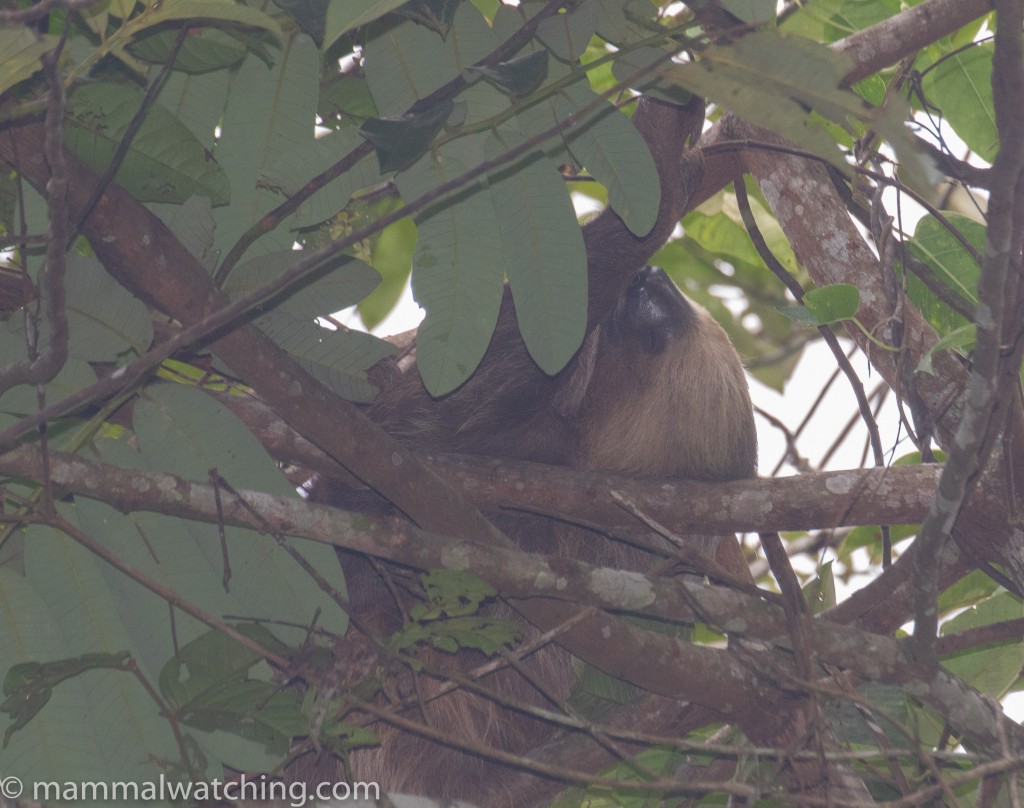
Hoffmann’s Two-toed Sloth, Choloepus hoffmanni
We saw the otters at least three times. The family of four seemed to like the creek and flooded forest in the saki monkey area, though late one morning we saw them out in the middle of the lake in front of the lodge.
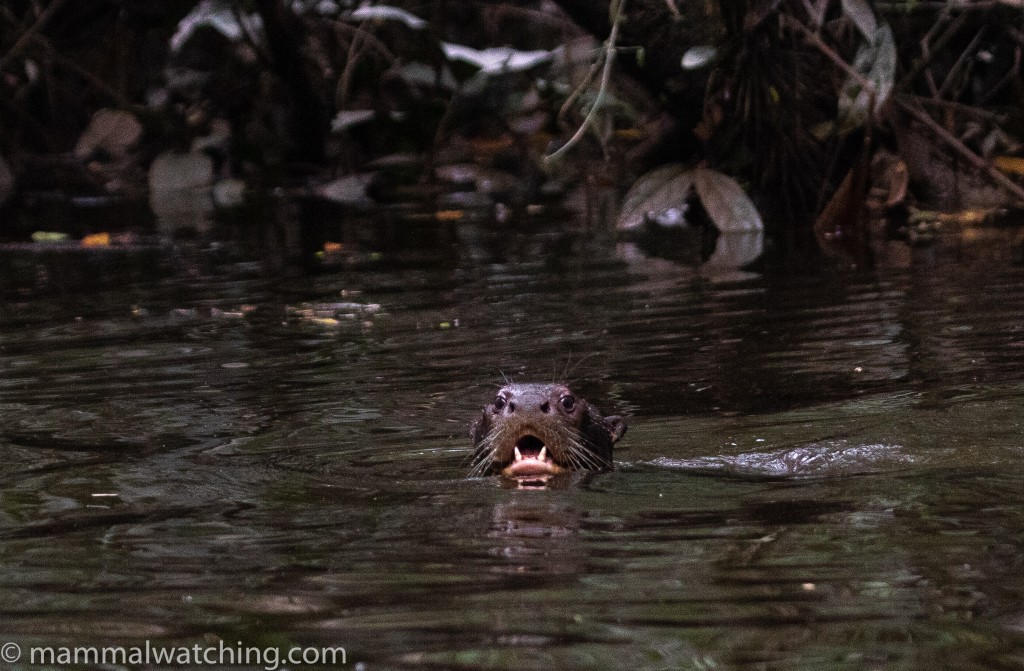
Giant Otter, Pteronura brasiliensis
If we had found the sakis as quickly as we ought to have we would have spent more time on the trails and likely seen a few others species.
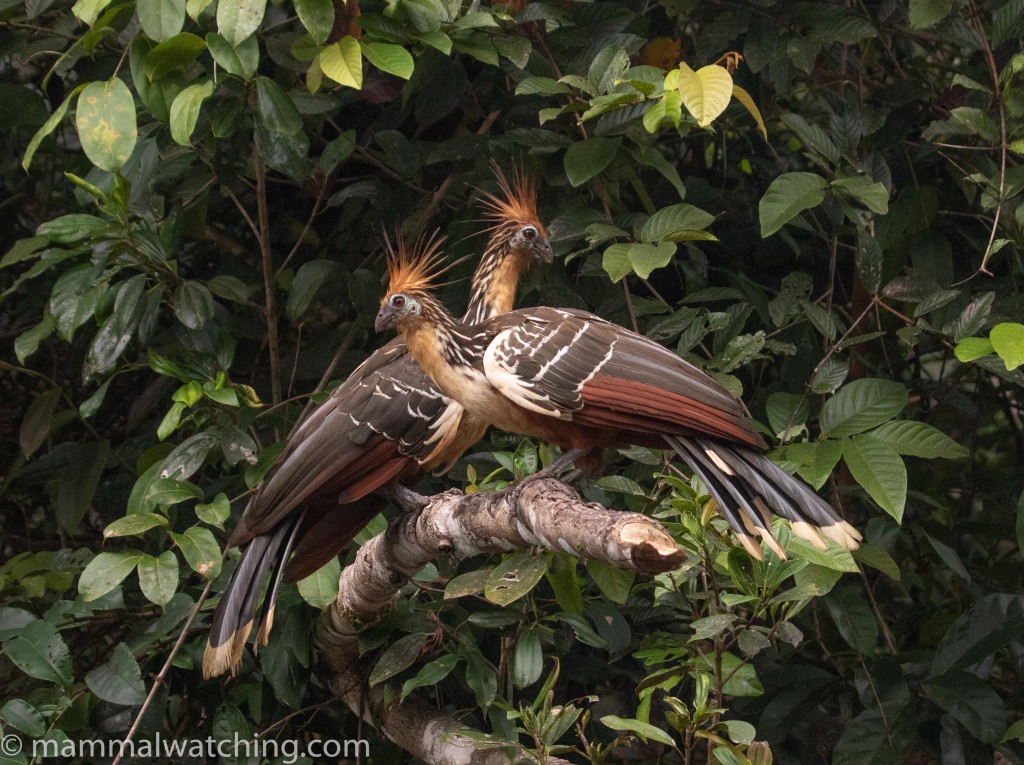
Hoatzins
Thank you
Many thanks to all who helped me plan the trip including Ian Thomson, Cheryl Antonucci and John Rogers, plus the staff at Jocotours. And thank you too to Fiona Reid and Diego Tirira for identifying – or trying to identify – some of our bats and rats.
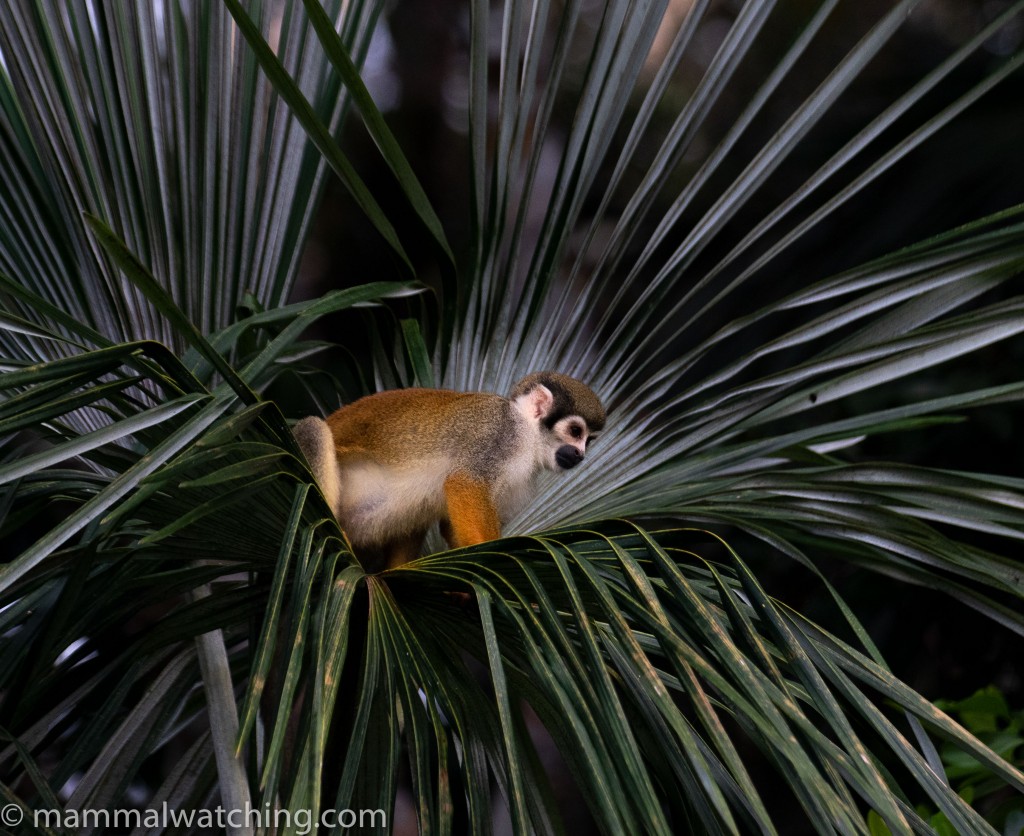
Ecuadorean Squirrel Monkey, Saimiri macrodon
A very big thanks to our various guides, particularly Delfin at the NWC and Jose Gallardo our fabulous driver and guide.
And finally – of course – to Alex for being such an easy bloke to travel with, and for spotting so many mammals.
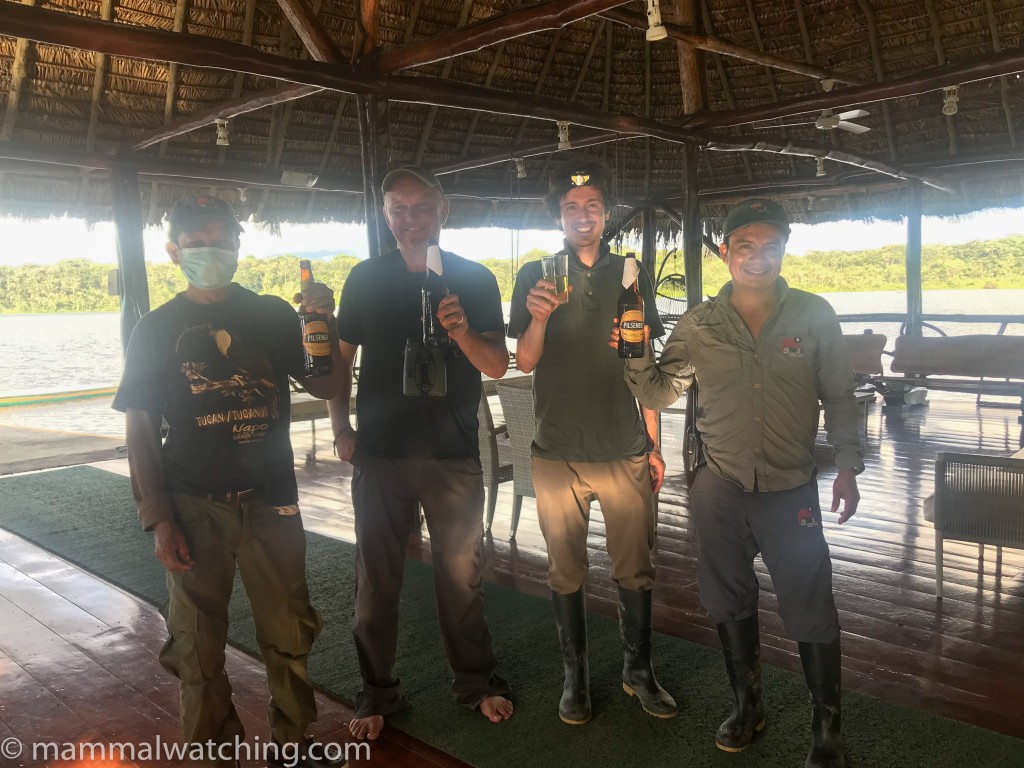
Saki celebration
Trip List
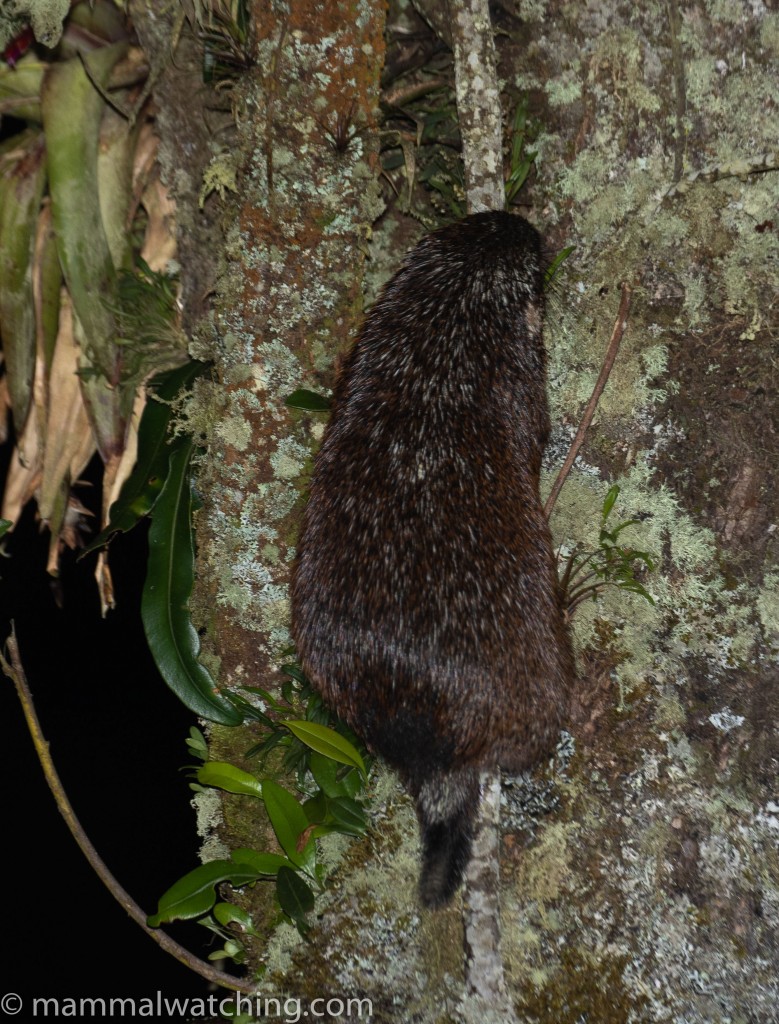
Stump-tailed Porcupine, Coendou rufescens
DIDELPHIDAE
Andean White-eared Opossum (Didelphis pernigra)
MEGALONYCHIDAE
Hoffmann’s Two-toed Sloth (Choloepus hoffmanni)
DASYPODIDAE
Nine-banded Armadillo (Dasypus novemcinctus) (Alex only)
LEPORIDAE
Andean Rabbit (Sylvilagus andinus)
ERETHIZONTIDAE
Stump-tailed Porcupine (Coendou rufescens)
CUNICULIDAE
Paca (Councils paca)* (Delfin and Alex only)
DASYPROCTIDAE
Black Agouti (Dasyprocta fuliginosa)
Central American Agouti (D.punctata)
SCIURIDAE
Red-tailed Squirrel (Sciurus granatensis)
CRICETIDAE
Taczanowski’s Oldfield Mouse (Thomasomys taczanowskii) – possibly
CALLITRICHIDAE
Golden-mantled Saddleback Tamarin (Leontocebus tripartitus)
CEBIDAE
Ecuadorean Squirrel Monkey (Saimiri macrodon)
Marañó White-fronted Capuchin (Cebus yuracus)
AOTIDAE
Grey-bellied Night Monkey (Aotus lemurinus)
PITHECIIDAE
White-tailed Titi Monkey (Plecturocebus discolor)
Napo Saki (Pithecia napensis)
ATELIDAE
Mantled Howler Monkey (Alouatta palliata)
Venezuelan Red Howler Monkey (A.seniculus)
White-bellied Spider Monkey (Ateles belzebuth)
Brown-headed Spider Monkey (A.fusciceps)
Common Woolly Monkey (Lagothrix lagothricha)
SORICIDAE
Ecuadorean Small-eared Shrew (Cryptotis equatoris)
EMBALLONURIDAE
Proboscis Bat (Rhynchonycteris naso)
Lesser Fishing Bat (Noctilio albiventris)
PHYLLOSTOMIDAE
Tube-lipped Tailless Bat (Anoura fistulata)
Fringe-lipped Bat (Trachops cirrhosus)
Greater Spear-nosed Bat (Phyllostomus hastatus)
Common Long-tongued Bat; Pallas’s Long-tongued Bat (Glossophaga soricina)
Seba’s Short-tailed Bat (Carollia perspicillata)
VESPERTILIONIDAE
Montane Myotis (Myotis oxyotus)
PROCYONIDAE
Olinguito (Bassaricyon neblina)
Kinkajou (Potos flavus)
MUSTELIDAE
Tayra (Eira barbara)
Giant Otter (Pteronura brasiliensis)
URSIDAE
Spectacled Bear (Tremarctos ornatus) (Jose only)
CERVIDAE
White-tailed Deer (Odocoileus virginianus)
36 species, 6 lifers in bold.
Plus very tentative Soft Grass Mouse, Akodon Mollis, at San Tadeo, and White-footed Climbing Mouse, Rhipidomys leucodactylus at San Isidro. Alex also saw an Andean Fox on his return to Papallacta.
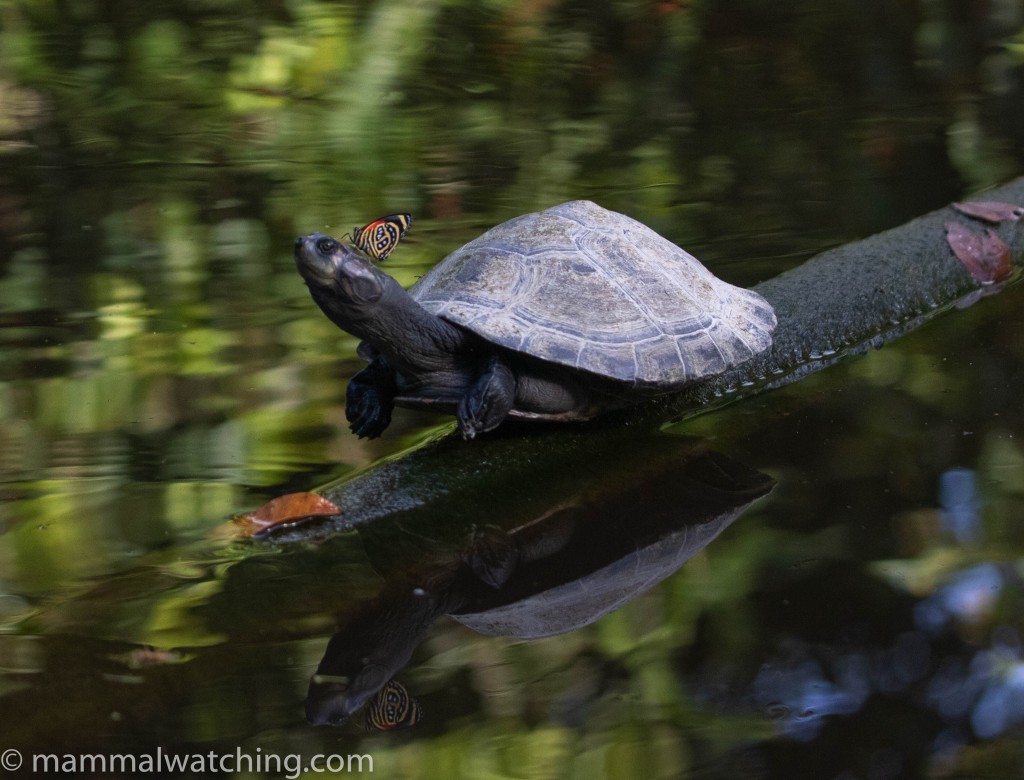
13 Comments
-
-
Vladimir Dinets
I was in NWC in 2010 for something like two weeks studying caimans, got a ridiculously long species list there (I was allowed to catch some small mammals). I thought I’d written a trip report but apparently not. Sorry about that – would’ve saved you some time on looking for bat roosts, assuming all the sheds etc. are still in the same places.
-
-
-
John Fox
We were at NWC once and had a power boat available for an afternoon (on the river, no motors on the creek or at the lodge, part of what makes it such a great place). We thought about going across the river to the other lodge but there was some resistance to it, like someone had to go over ahead of time and negotiate the visit. Maybe a tribal thing. So we went looking for dolphins instead (with no luck).
-
Maurice Tijm
Great report again Jon. Lovely photos of that really stunning saki and porcupine.
Great primates too. I remember that others had a lot less luck finding black agouti around EcuadorToo good stakeouts like the one for the coati are always the most nerve-breaking parts of a trip! Especially beforehand (will it come, how much time should we put in etc.). It is a lot more frustrating to dip a great species at a stakeout than during nightdrives. Just sitting there, all day or night looking a food scraps no skills involved. I dipped quite a few species that were supposed to visit for food scraps. The sun bear in kaen krachan NP Thailand for example :’-(.
Such a special experience at Napo. From this and other reports it is clear that Ecuador is full of dream mammals (andean bear, mountain tapir etc) but not an easy place to see them. All the sites look stunning though and worth a visit anyway.
-
tomeslice
How have I not seen this??
As the #1 subscriber to the blog, I’m deeply disappointed in myself.. lol.First of all – great report, even though you missed the mountain coati (another reason to go back!…) you got to see all kinds of cool stuff for which I’m jealous.
And of course I’m honored for my mention as an entertaining travel companion… 😀
Surely Alex and I clicked well, but it sounds like you guys got along great as well, which I’m happy to read.Anyway, great report, and I need to check my subscription, as mammal watching posts should jump up in bold on my inbox.
-
giant eland
What a wonderful trek across Ecuador with you, Jon! Thank you so much for having me along! And I’m currently working on my report from the 3 weeks I spent in Brazil immediately afterward.
But first, a note about my not-so-triumphant return to Papallacta:
During our initial visit, I set plans with Mario for the two extra days I would spend in Papallacta after Jon departed. But when I came back, Mario wasn’t there. Two hours late turned into four hours late turned into not showing up at all. I was pretty frustrated considering I had changed my flight and paid our driver Jose to have this extra time at Papallacta to look for Mountain Tapir, Andean Bear and (if we got super lucky) Shrew Opossums at night.
I was at least able to convince Termas Hotel to allow Jose and I into the park at night by signing a waiver. A helpful (and cheap) option if Mario leaves you high and dry.
Leave a Reply
You must be logged in to post a comment.


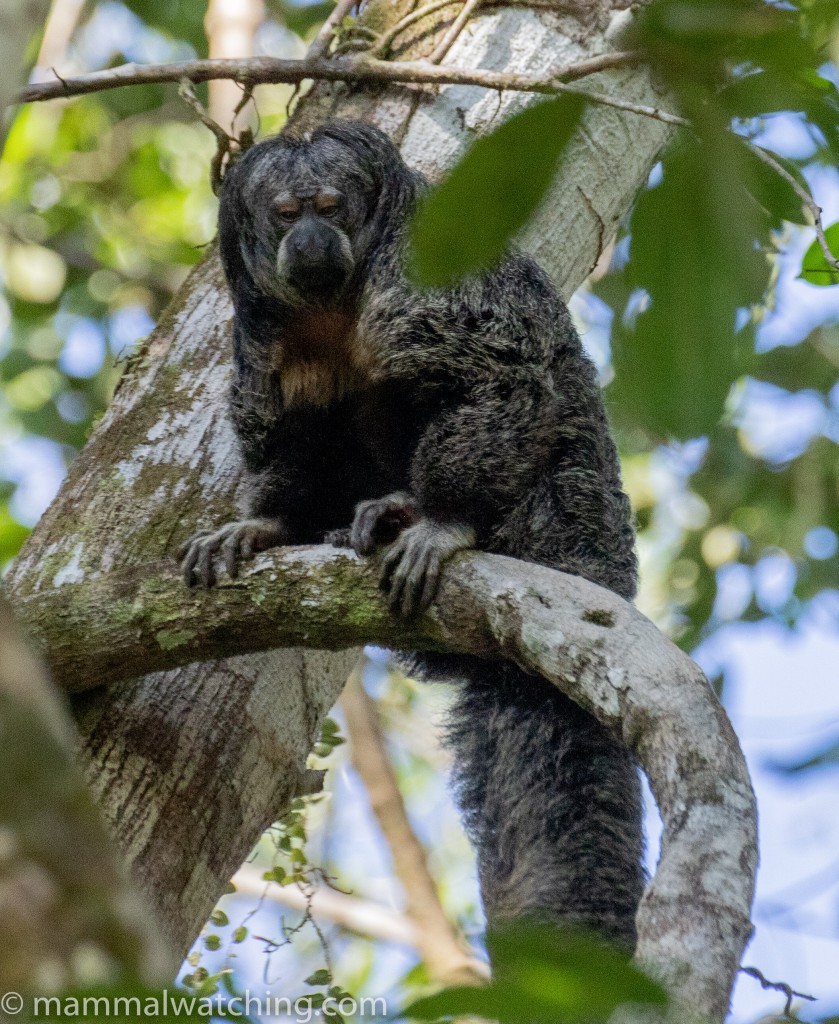
Karina and Andrey
The fact that you missed the mountain coati is a heavy blow for us… We are so sorry…
By the way, we found some evidence that the beast has been visiting San Tadeo for years but the information was hidden from mammalwatchers’ eyes because of the incomplete or wrong name “coati /coatimundi” .
Here are the links-
2017 (scroll for nice coati photos!)
https://rickdunlap.net/archives/1309
2018
https://www.tripadvisor.com/ShowUserReviews-g609138-d866726-r563632408-San_Jorge_de_Milpe_Eco_Lodge_Orchid_Bird_Reserve-Mindo_Pichincha_Province.html
2019
https://www.facebook.com/watch/?v=2848183085191789
Thus, it is not as easy as we supposed but it seems that it makes sense to try to see this species there. Hopefully, it will return to more regular and prolonged visits to the bird feeder at San Tadeo in the future.
We feel your pain. Stay strong, Jon.